Beijing, China – Monday, August 29th, 2016
In August 2016 Yiyan and I left for our first trip to China together to see her family, with a stop in Beijing on the way there. (We also stopped at Shanghai Disneyland on the way back.) Provided you fly during the right season and with Chinese airlines, direct airfare to Beijing can be quite affordable, with this Air China flight costing not much more out of LAX than we’ve paid for similar flights to Chicago.
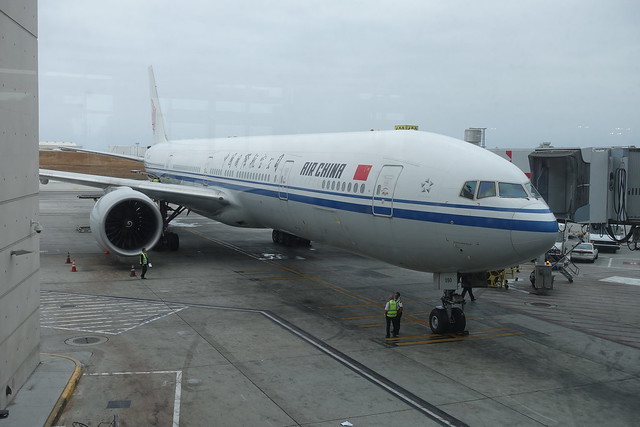 Once we landed, our first order of business was food, specifically Beijing style hot pot. Take the thin strips of meat and other veggies, dunk them in the boiling broth for a minute or so, and then dip it with a sesame sauce to cool it down and enjoy. Beijing style is much milder than the Sichuan style I last tried in China in 2011.
Once we landed, our first order of business was food, specifically Beijing style hot pot. Take the thin strips of meat and other veggies, dunk them in the boiling broth for a minute or so, and then dip it with a sesame sauce to cool it down and enjoy. Beijing style is much milder than the Sichuan style I last tried in China in 2011.

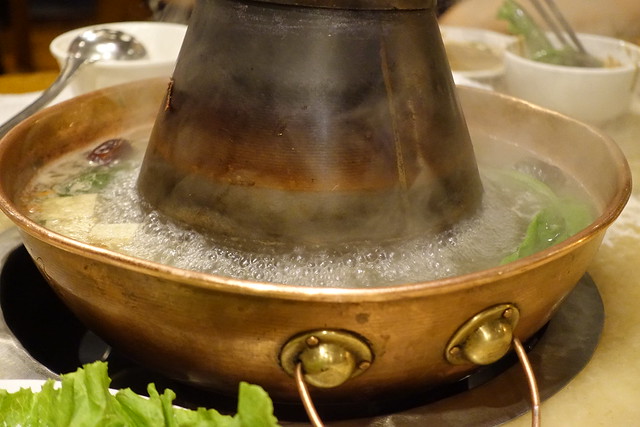 Up bright and early the next morning for touring the Forbidden City, the day began with dumplings. (There’s very little food available inside the city, so it’s wise to plan your meals immediately before and immediately after the Forbidden City, which can take nearly a half day to see.)
Up bright and early the next morning for touring the Forbidden City, the day began with dumplings. (There’s very little food available inside the city, so it’s wise to plan your meals immediately before and immediately after the Forbidden City, which can take nearly a half day to see.)
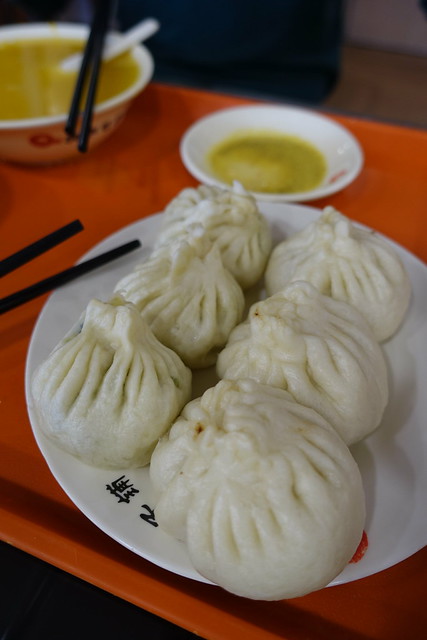 We’re ready to take on the Forbidden City!
We’re ready to take on the Forbidden City!
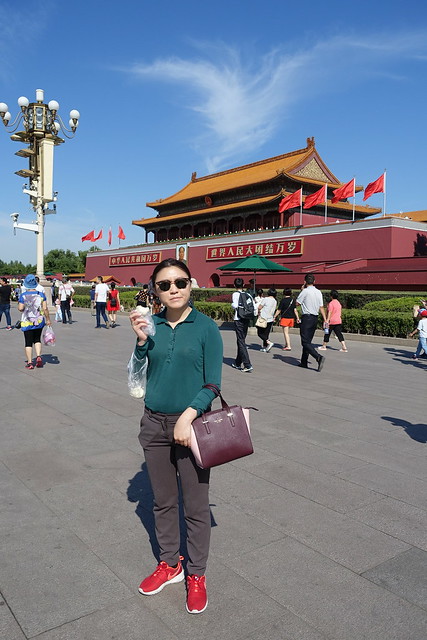 Entry to the Forbidden City (otherwise known as “The Palace Museum”) is through Tienanmen Gate.
Entry to the Forbidden City (otherwise known as “The Palace Museum”) is through Tienanmen Gate.
As is traditional in Chinese architecture, two stone lions guard over the entrance. These date from 1420.
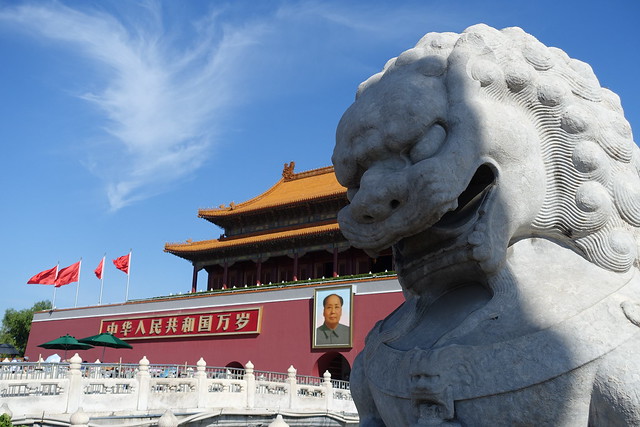
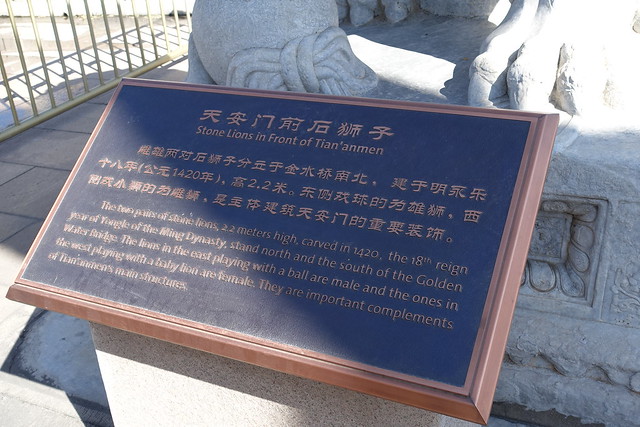 Tienanmen Gate also has these impressively carved white marble ornamental columns, equally as old. (Equally as impressive is how clear and blue the skies are. Apparently late August/September, in addition to having favorable airfare rates, is one of the times when air pollution is typically at its lowest in Beijing.)
Tienanmen Gate also has these impressively carved white marble ornamental columns, equally as old. (Equally as impressive is how clear and blue the skies are. Apparently late August/September, in addition to having favorable airfare rates, is one of the times when air pollution is typically at its lowest in Beijing.)
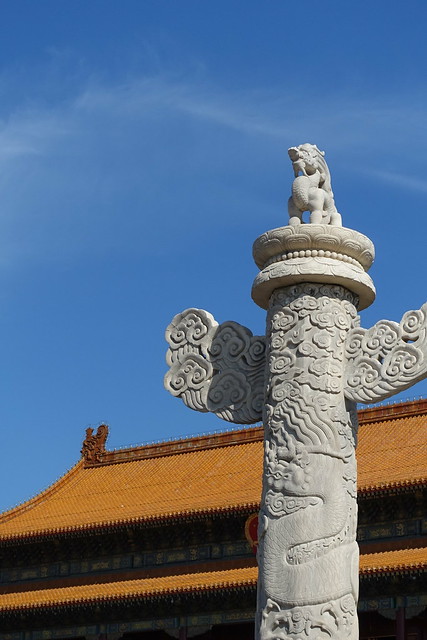
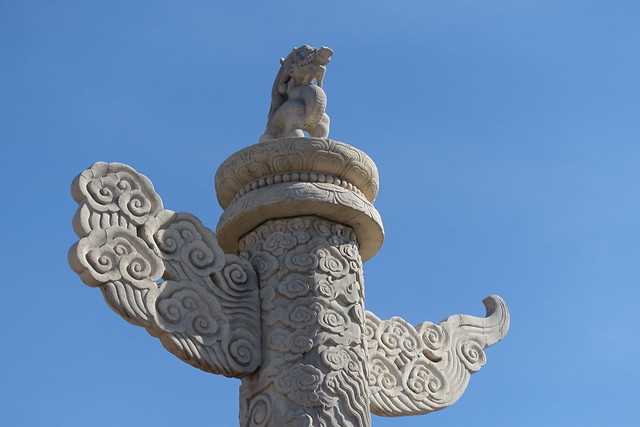
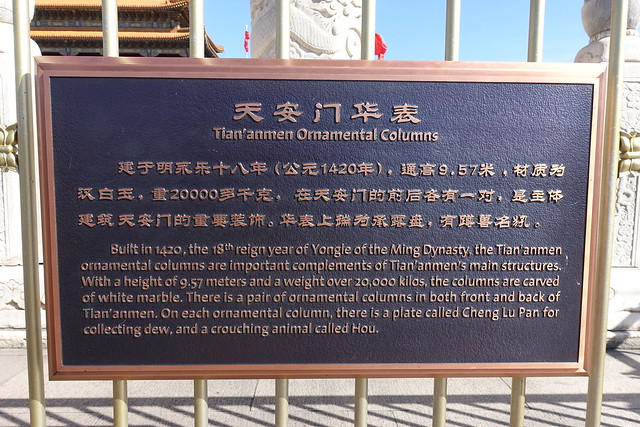 Mao watches over as we enter. Just to remind everyone who’s really in charge now.
Mao watches over as we enter. Just to remind everyone who’s really in charge now.
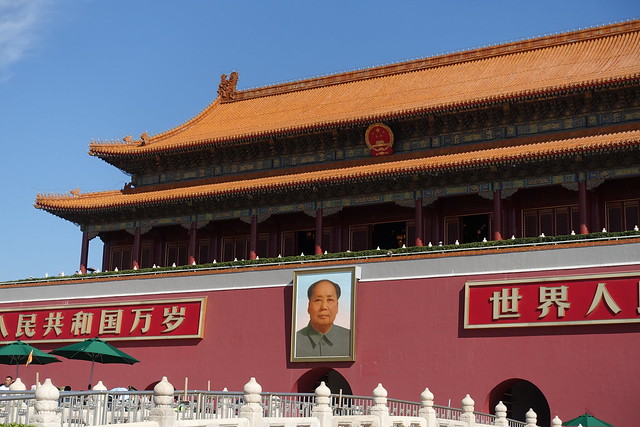
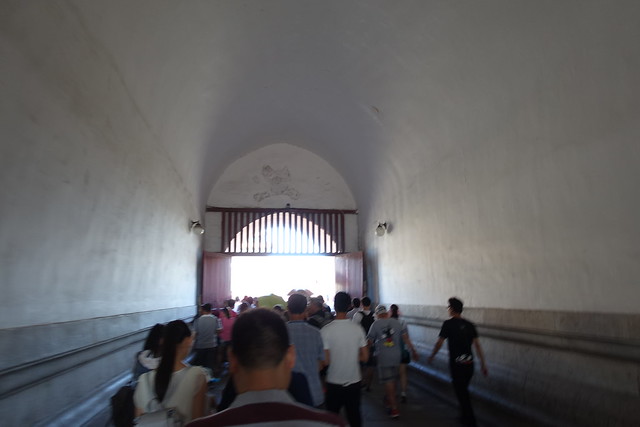 Technically we’ve only passed the outer fortification, and apart from the security checkpoint it’s open to the public. In this square is where ticketing for the Palace Museum is set up, and the Meridian Gate up ahead signifies the actual entrance to the Forbidden City. The Palace Museum is the most visited museum in the world, but it spreads out over such a massive space that most days you couldn’t tell.
Technically we’ve only passed the outer fortification, and apart from the security checkpoint it’s open to the public. In this square is where ticketing for the Palace Museum is set up, and the Meridian Gate up ahead signifies the actual entrance to the Forbidden City. The Palace Museum is the most visited museum in the world, but it spreads out over such a massive space that most days you couldn’t tell.
Approaching the Meridian Gate.
We also got a pair of audio tour guides for something like $4 each. While the thick green plastic casing felt like museum tech from 25 years ago, it actually worked quite seamlessly, using some form of location tracking (maybe RFID?) to automatically trigger relevant audio narration and even recommended walking routes, with small lights tracking where you’ve already been. Useful, as the massive outdoor Palace Museum can be a bit inexplicable. With the headphones on, we could put the device in our pocket and forget about it. Recommended.
Ongoing renovations are a fact of life for a 600 year old wooden palace made without a single nail.
The first part of the tour consists of passing through a grandiose series of halls, each seemingly trying to out-impress the last. Like many theme parks, the Forbidden City’s builders put great emphasis on creating a strong arrival sequence. The structure ahead of us is just another gate (the third so far).
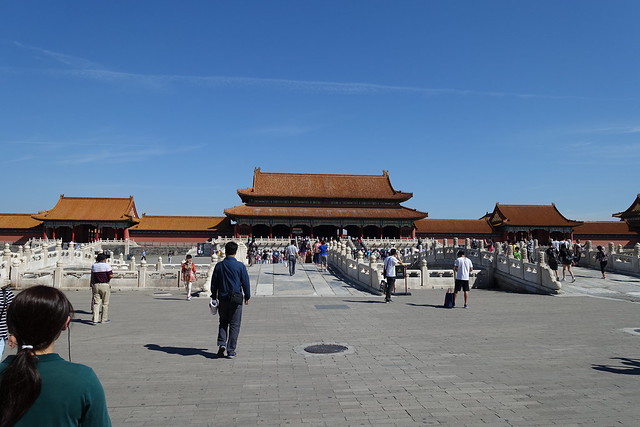 We first cross the Golden Water Bridges.
We first cross the Golden Water Bridges.

 This is the Gate of Supreme Harmony, first built in 1420 but rebuilt in 1888 after a fire.
This is the Gate of Supreme Harmony, first built in 1420 but rebuilt in 1888 after a fire.
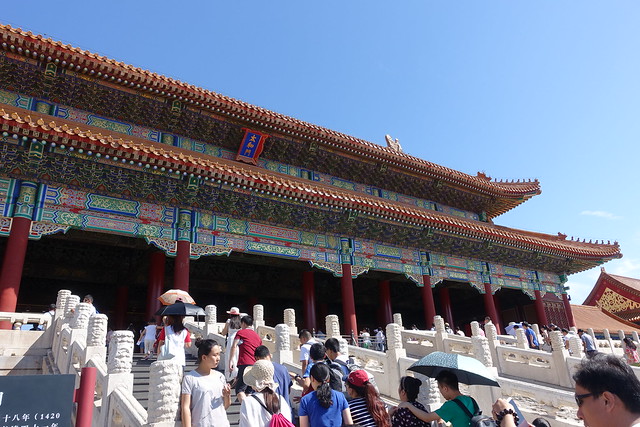
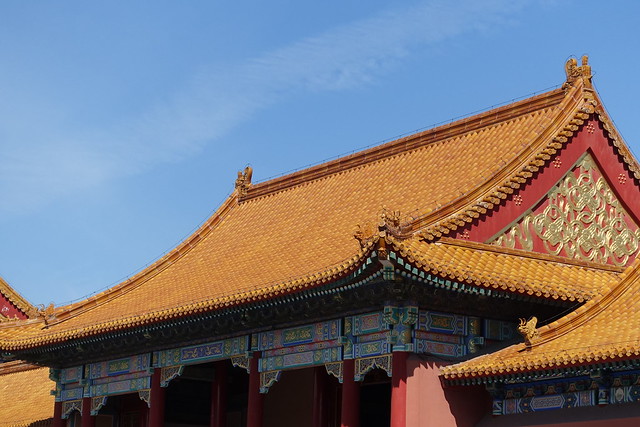
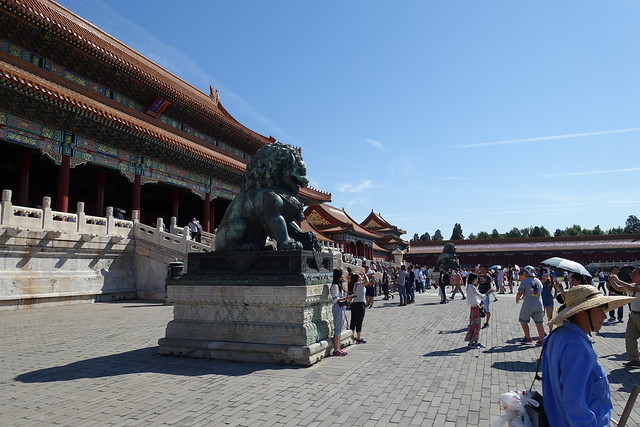

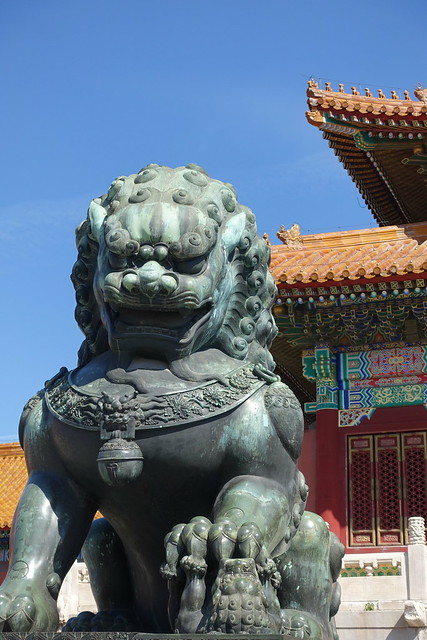 A more detailed introduction to the Palace Museum:
A more detailed introduction to the Palace Museum:
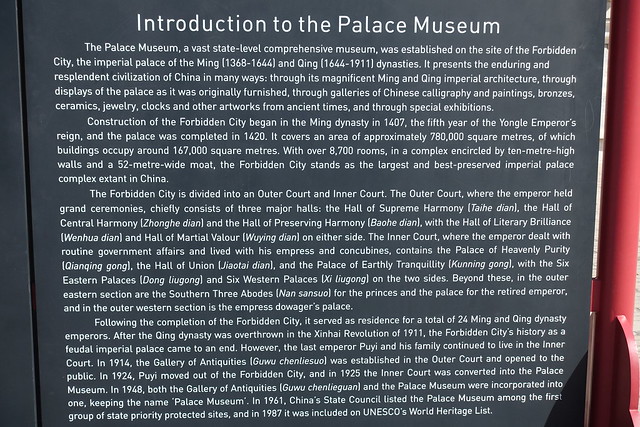 The Forbidden City is impressive at both large scales and small details.
The Forbidden City is impressive at both large scales and small details.
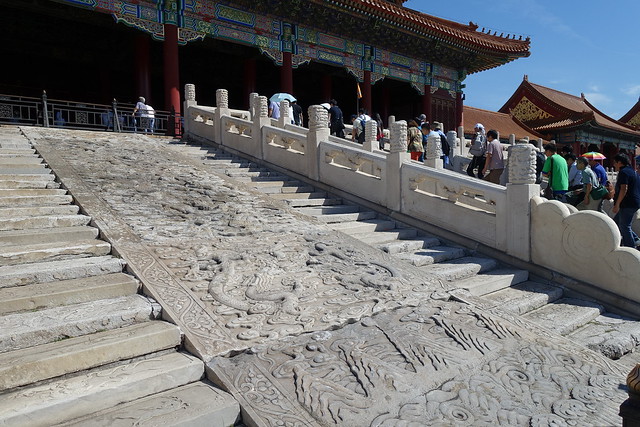
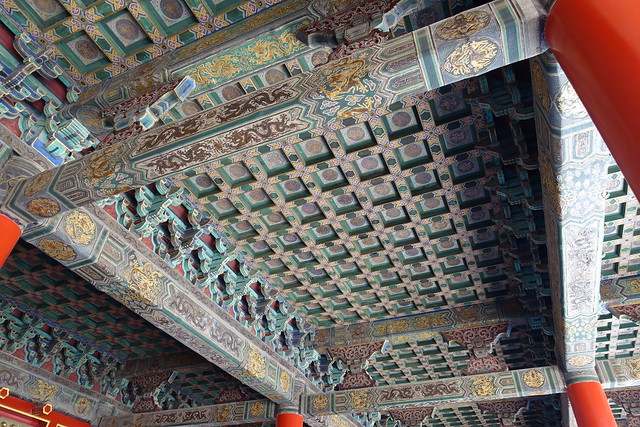 And now the grand reveal: The Hall of Supreme Harmony.
And now the grand reveal: The Hall of Supreme Harmony.
Modern Beijing peeks out beyond the gates of the Forbidden City.
More cool artifacts, such as stone carved ramps, a grain measurer, and a kick-ass dragon-turtle.
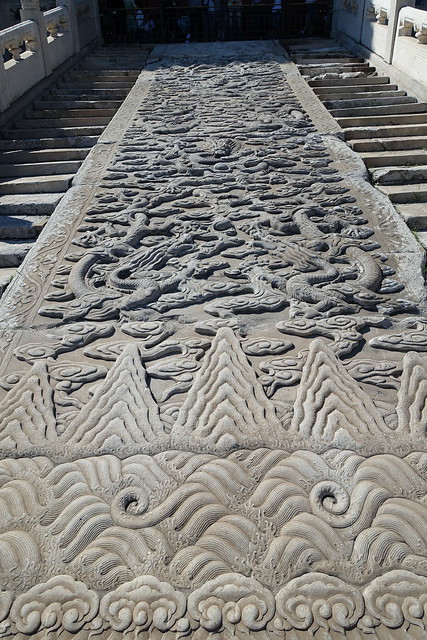



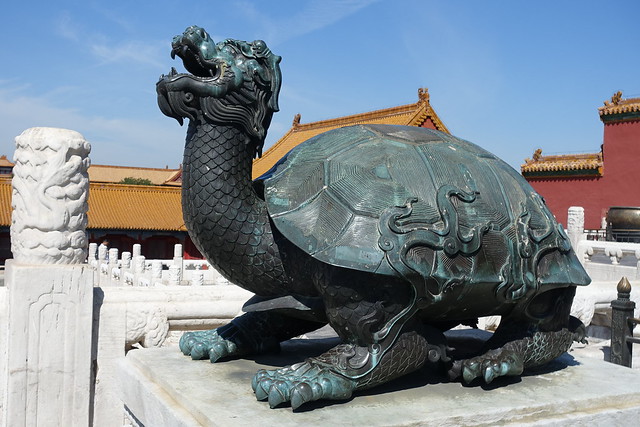 Symbols change meaning with time:
Symbols change meaning with time:
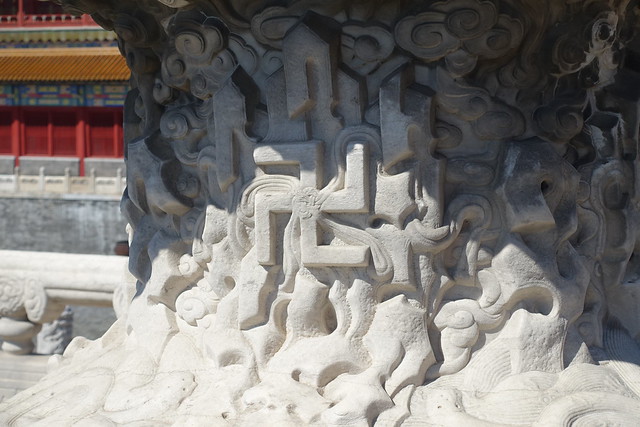 Notice these details on the corners of all the roofs. I believe the carved figures are meant to ward off intruders or evil spirits, and in general the more figures there are, the more important the building is to protect. The Hall of Supreme Harmony is obviously a very important building. (I guess the wires are to guard the guardians from more banal intruders such as birds.)
Notice these details on the corners of all the roofs. I believe the carved figures are meant to ward off intruders or evil spirits, and in general the more figures there are, the more important the building is to protect. The Hall of Supreme Harmony is obviously a very important building. (I guess the wires are to guard the guardians from more banal intruders such as birds.)

 Crowding around for a peek inside the Hall of Supreme Harmony. Imagine this scene during a Chinese holiday instead of an off-peak Monday.
Crowding around for a peek inside the Hall of Supreme Harmony. Imagine this scene during a Chinese holiday instead of an off-peak Monday.
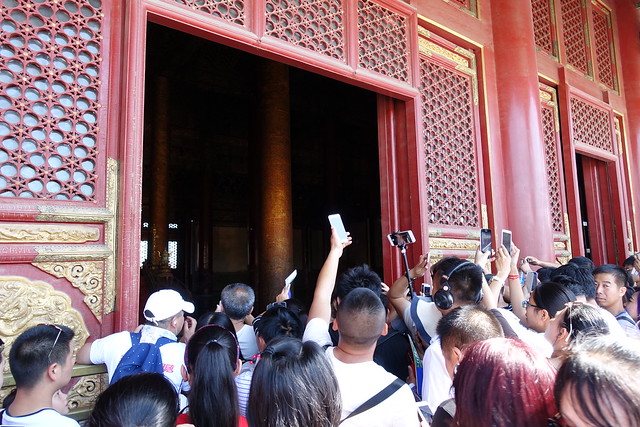
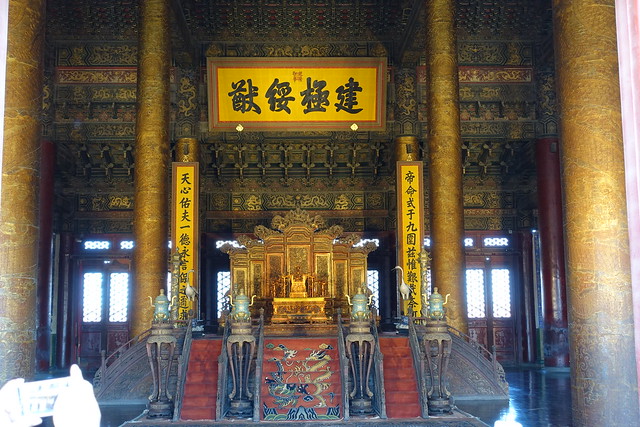 More details and artifacts around the hall:
More details and artifacts around the hall:
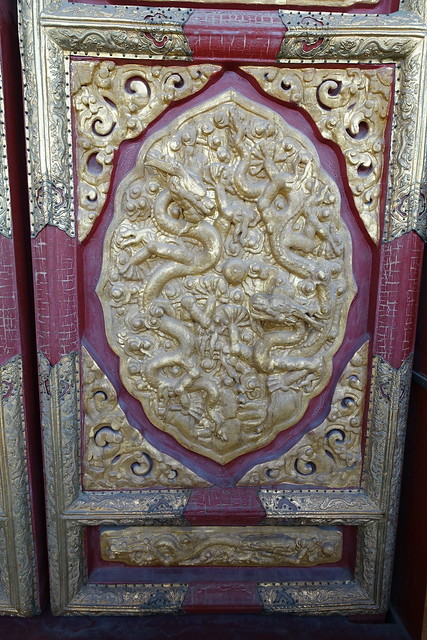

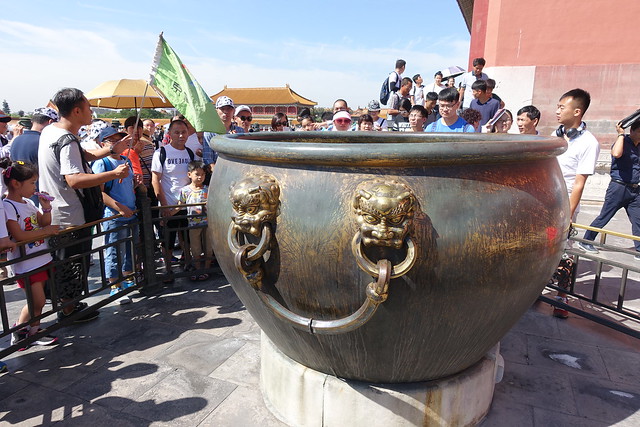 Onward to the next area: The Hall of Central Harmony. (All the building names are like this.)
Onward to the next area: The Hall of Central Harmony. (All the building names are like this.)
 The rear view of the Hall of Supreme Harmony. By this point many people are already worn out, and we’ve only gotten to the first hall!
The rear view of the Hall of Supreme Harmony. By this point many people are already worn out, and we’ve only gotten to the first hall!
The Hall of Central Harmony (with the big ball on top) is not nearly as big, although it is surrounded by these cool multilevel marble steps and numerous side gates.
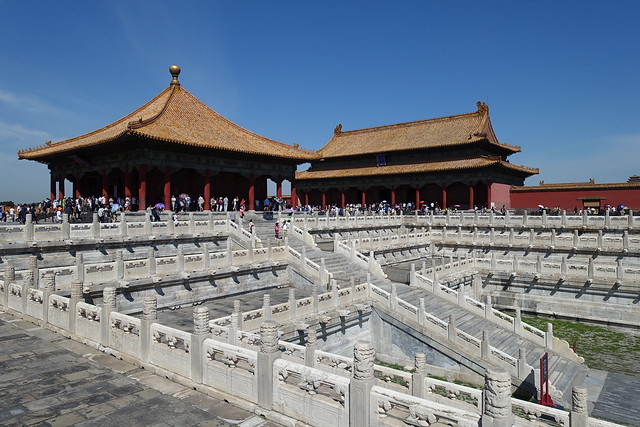
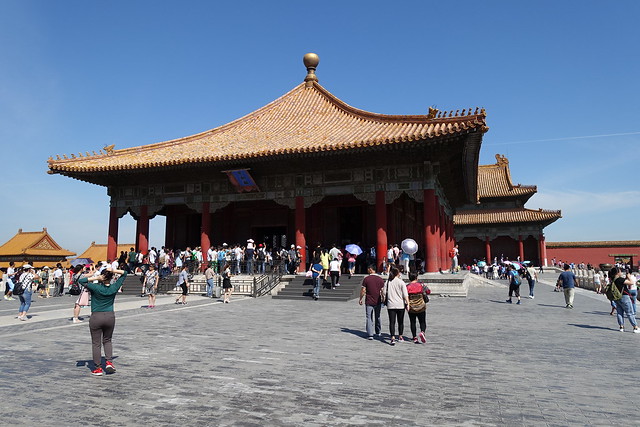
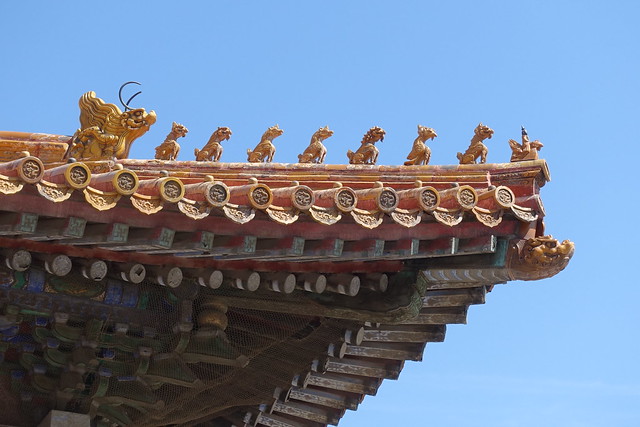
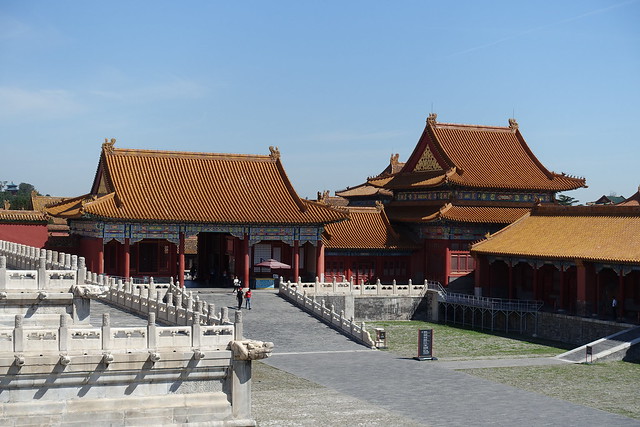
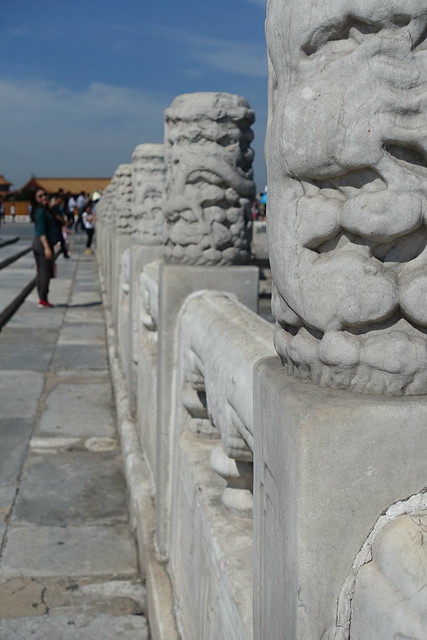
 Joining the hordes for a peek at the throne in the Hall of Central Harmony:
Joining the hordes for a peek at the throne in the Hall of Central Harmony:
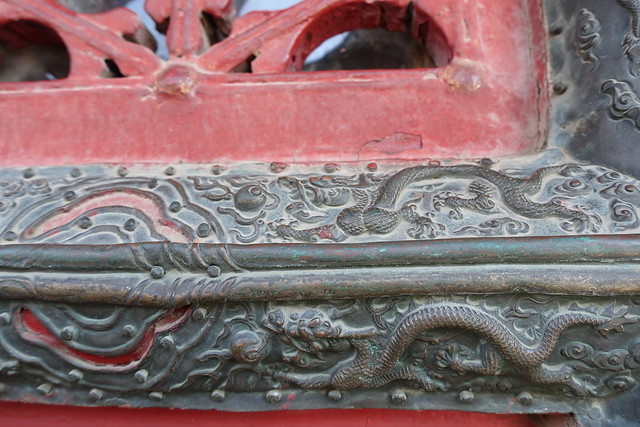 Next is the Hall of Preserving Harmony. (Last “Harmony” hall, I swear!)
Next is the Hall of Preserving Harmony. (Last “Harmony” hall, I swear!)
 Through the next gateway, we’re now done with the major halls, but there’s now lots of smaller halls and details to explore throughout the Forbidden City.
Through the next gateway, we’re now done with the major halls, but there’s now lots of smaller halls and details to explore throughout the Forbidden City.
Down here is the Gate of Heavenly Purity.
Take a moment on the way down to appreciate the intricate stone carvings along the stairs.
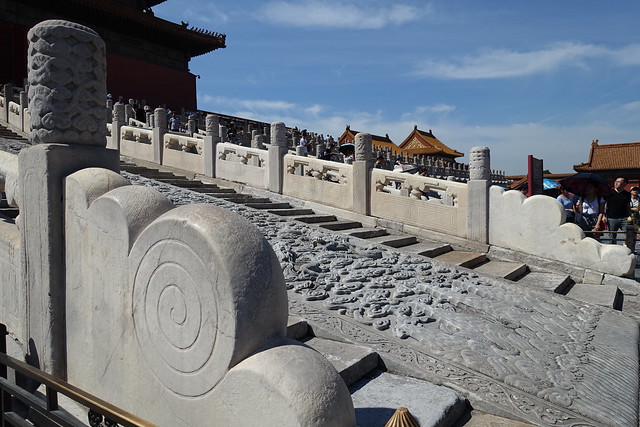
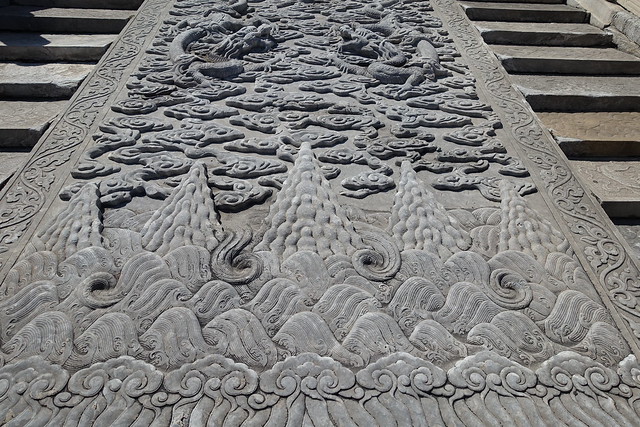
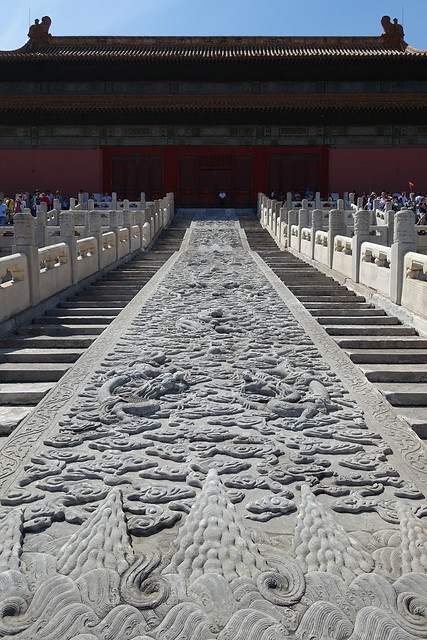

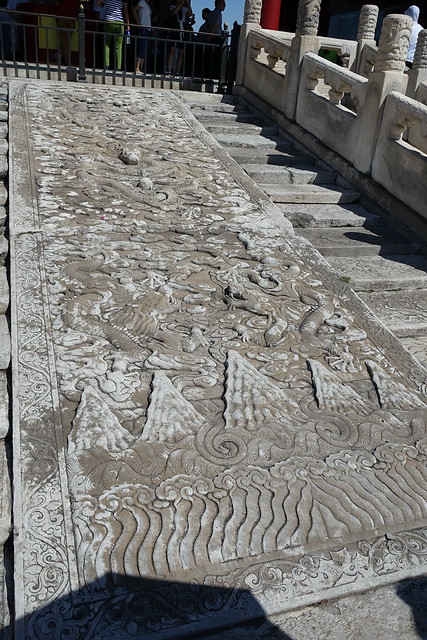
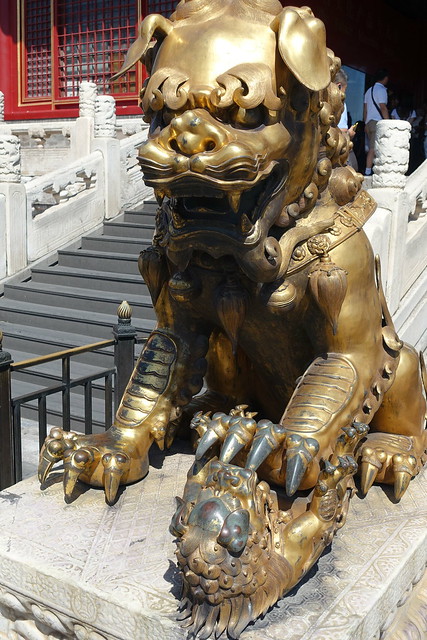 A map of the six Western Palaces area:
A map of the six Western Palaces area:
 Branching off the main axis route to explore the Western Palaces area:
Branching off the main axis route to explore the Western Palaces area:
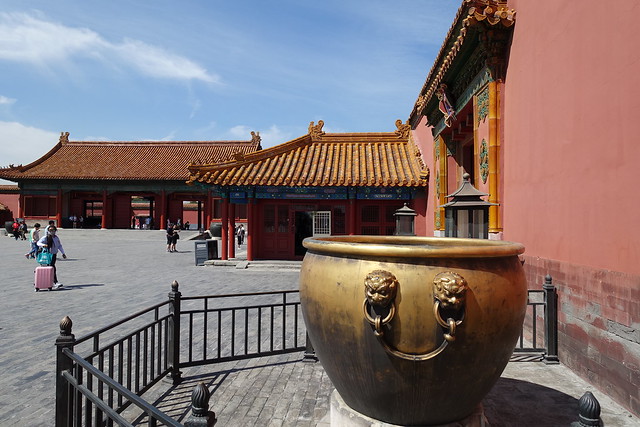

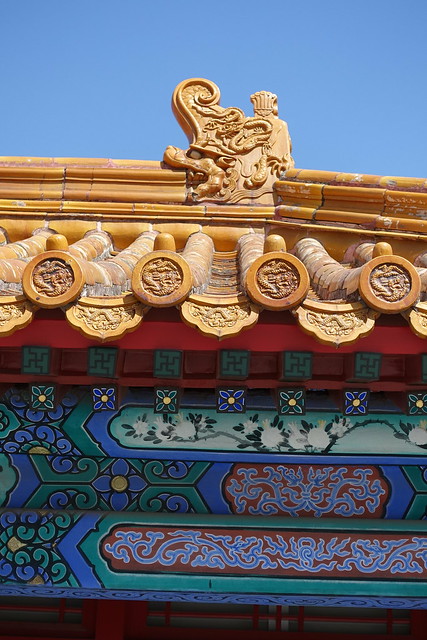
 A small museum in one of the buildings.
A small museum in one of the buildings.
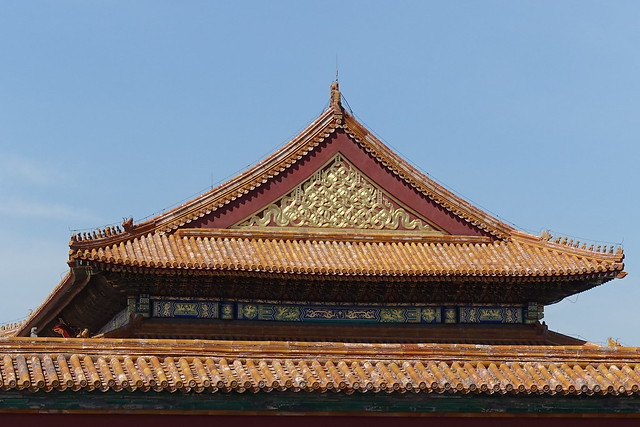



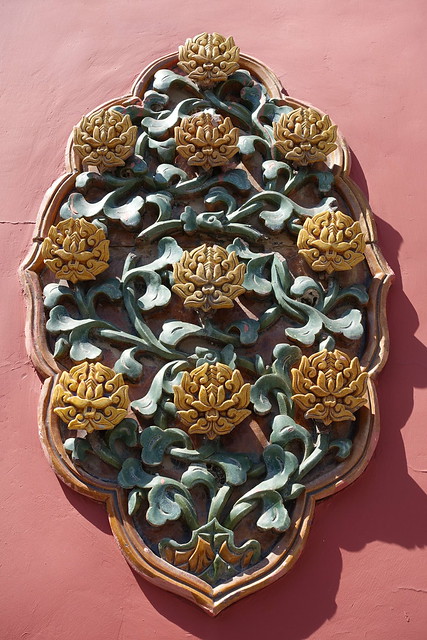 The ambitiously named Garden of Benevolent Tranquility:
The ambitiously named Garden of Benevolent Tranquility:
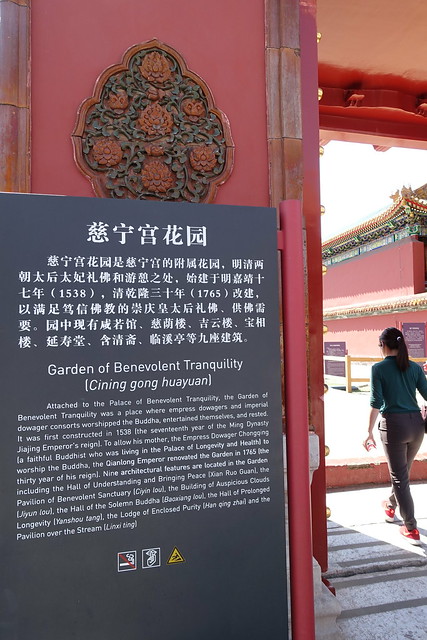
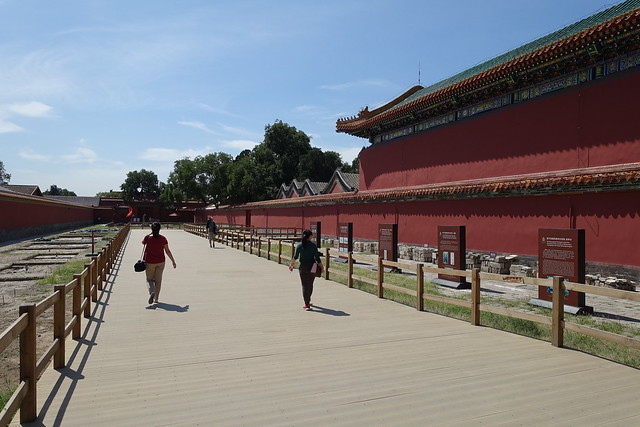 Ming dynasty tiled brick flooring:
Ming dynasty tiled brick flooring:
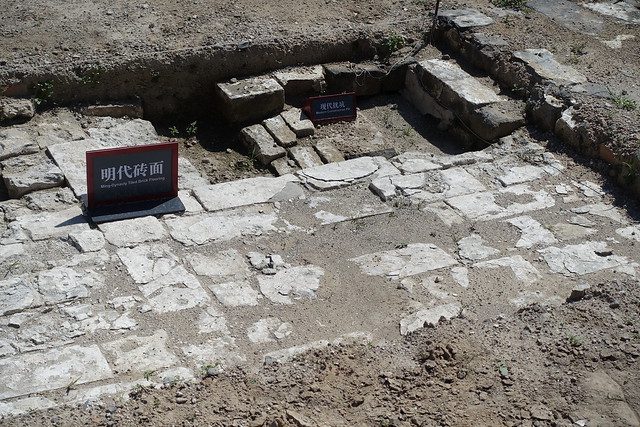 The Pavilion of Brook View, with some weird balloon sculptures next to it:
The Pavilion of Brook View, with some weird balloon sculptures next to it:

 The Palace of Compassion and Tranquility:
The Palace of Compassion and Tranquility:
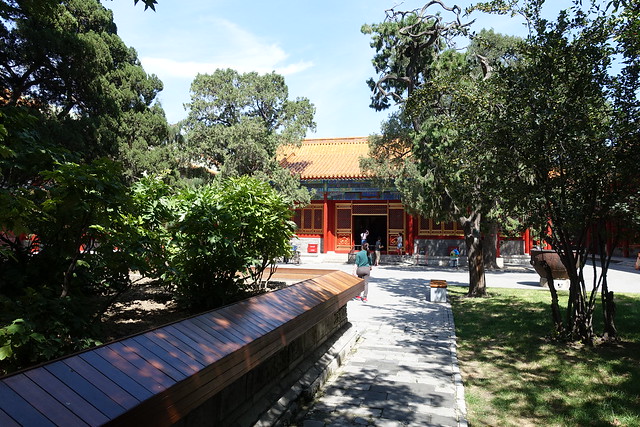

 A sculpture gallery is full of artifacts dating back over millennia.
A sculpture gallery is full of artifacts dating back over millennia.
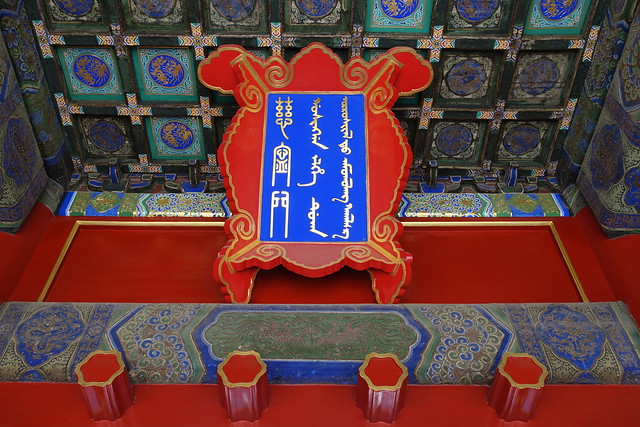




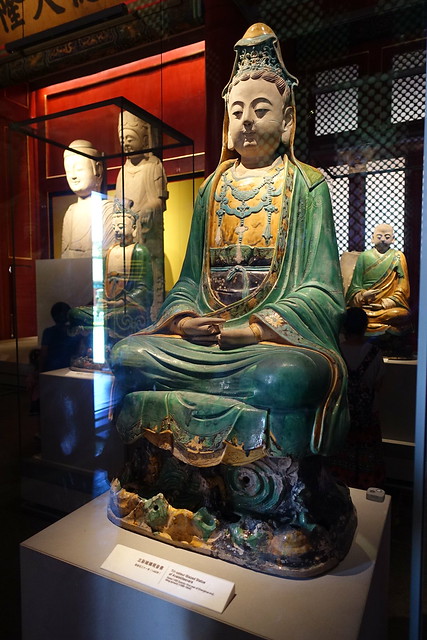
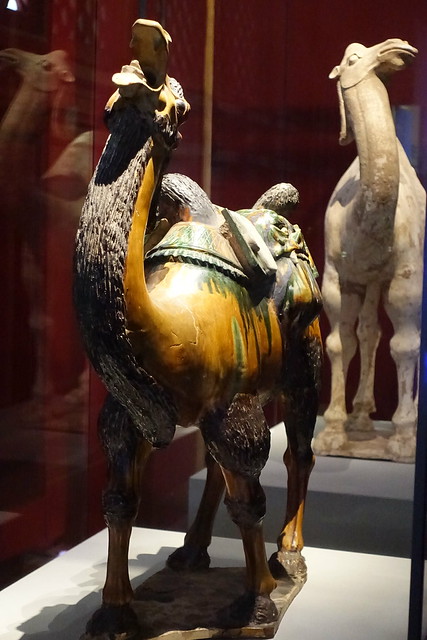 Wandering back to the center with the large structures.
Wandering back to the center with the large structures.
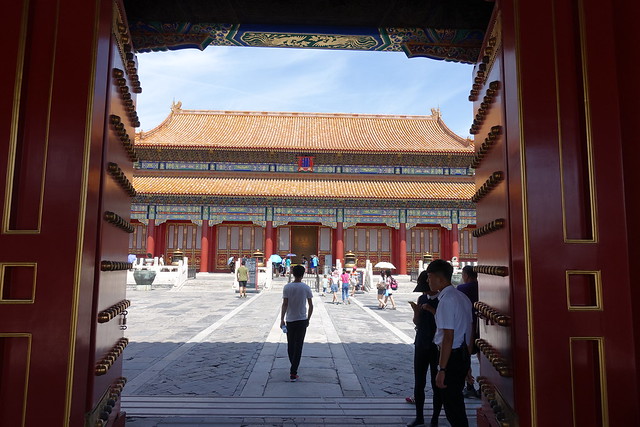 The Palace of Heavenly Purity:
The Palace of Heavenly Purity:
Love the interlocking hexagons in this stone carving:

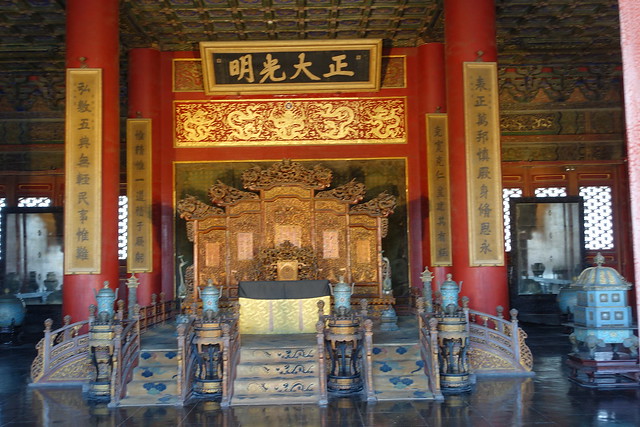 The Hall of Union, located between the Hall of Heavenly Purity and the Hall of Earthly Tranquility.
The Hall of Union, located between the Hall of Heavenly Purity and the Hall of Earthly Tranquility.

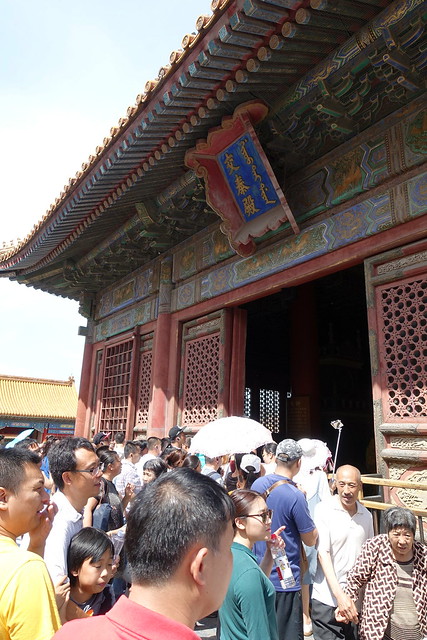
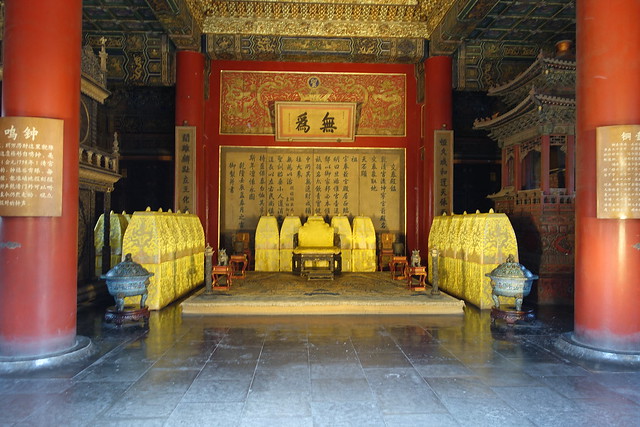
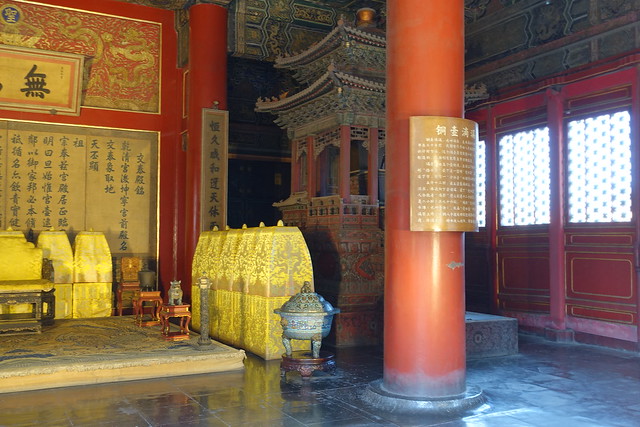
 And the Palace of Earthly Tranquility, which I learned is code for the place where the emperor could get it on, with the bed to prove it.
And the Palace of Earthly Tranquility, which I learned is code for the place where the emperor could get it on, with the bed to prove it.
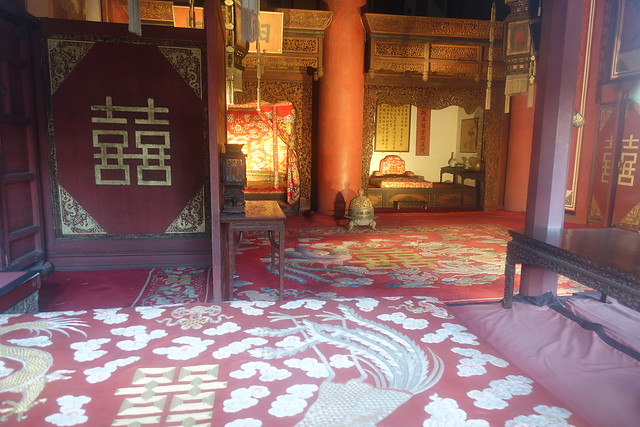
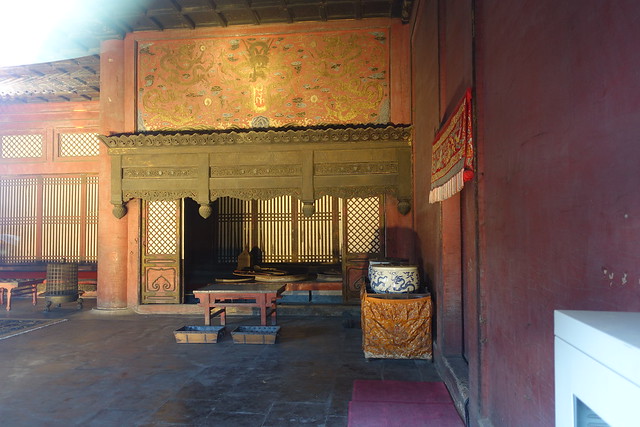
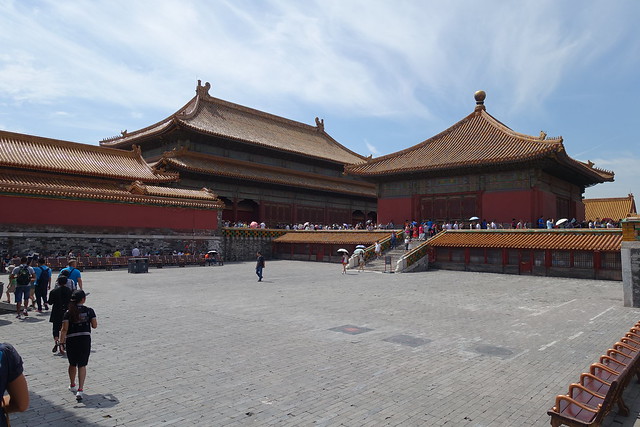 They name their gift shops like it’s RollerCoaster Tycoon!
They name their gift shops like it’s RollerCoaster Tycoon!
 Yes, even the Palace Museum isn’t above really embarrassing costumed photo ops if they can make a dime off it. So we figured we’d join them. Against my better judgement, I present the empress and her royal eunuch.
Yes, even the Palace Museum isn’t above really embarrassing costumed photo ops if they can make a dime off it. So we figured we’d join them. Against my better judgement, I present the empress and her royal eunuch.

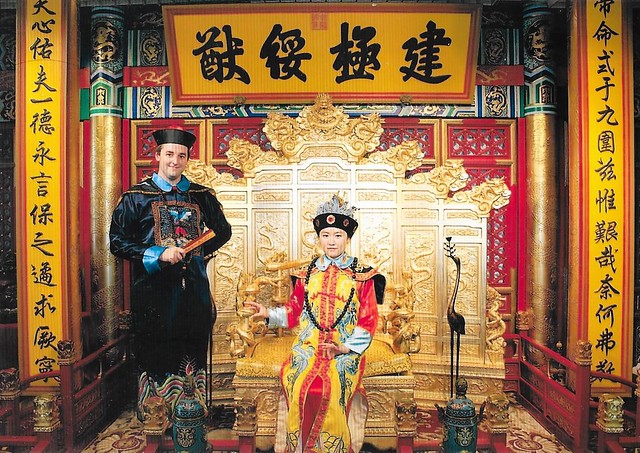
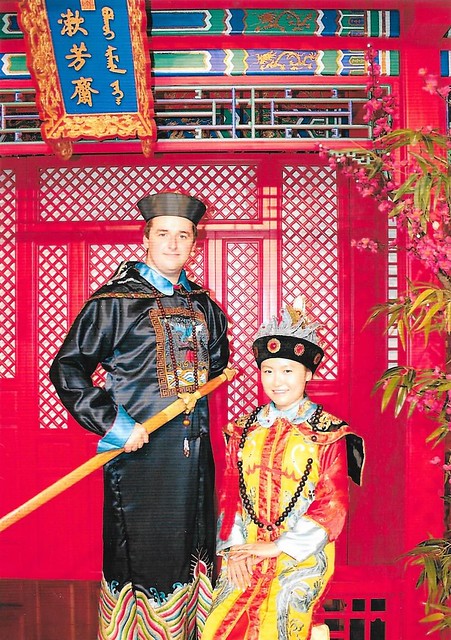 Onward to the Imperial Garden.
Onward to the Imperial Garden.
Looking up inside the Thousand-Year Pavilion and the Hall of Literary Elegance:


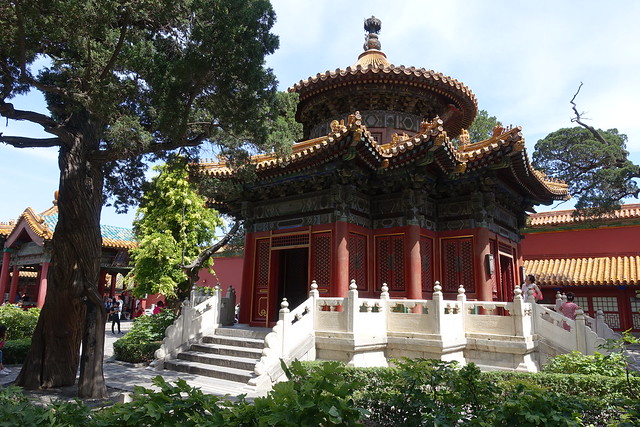
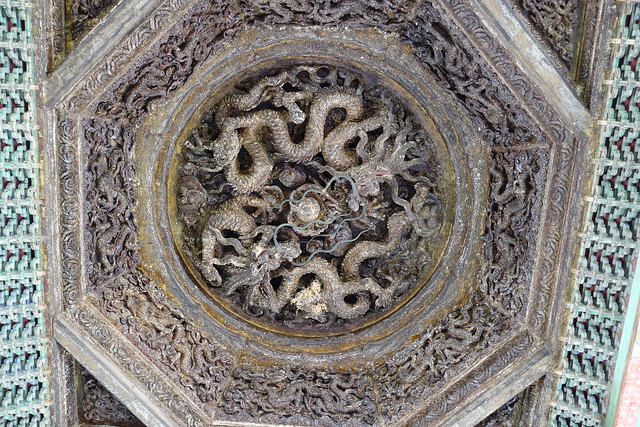
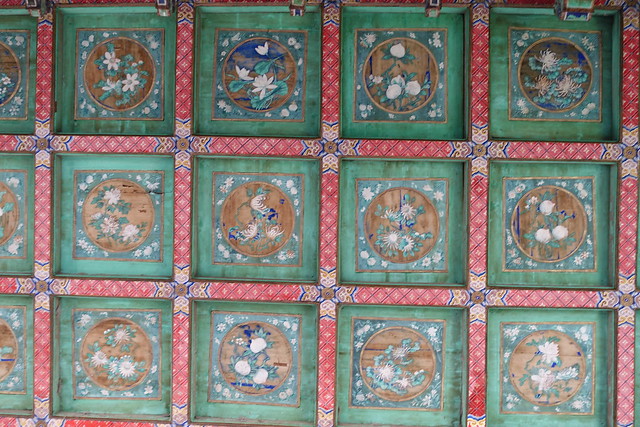 Continuing on to the Eastern Palace area.
Continuing on to the Eastern Palace area.
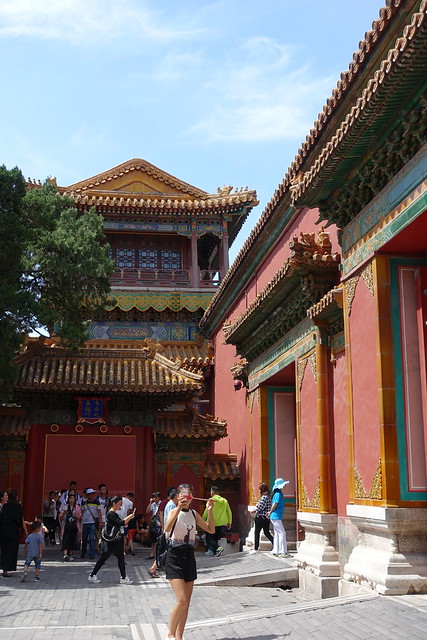

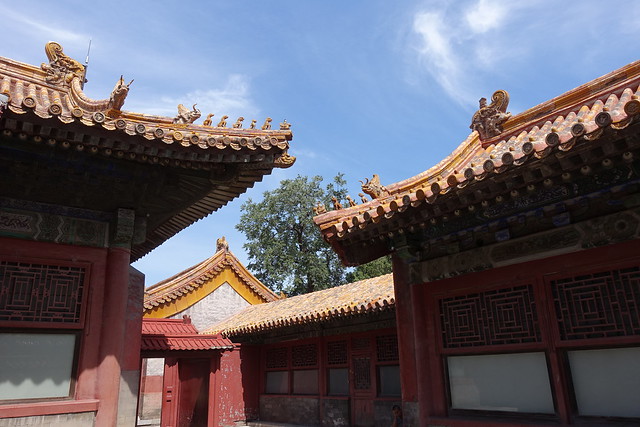
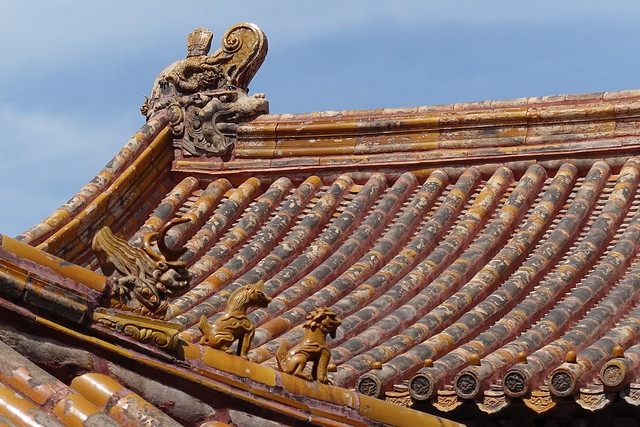 The Palace of Prolonging Happiness was lost to fire in the mid-1800’s, and was attempted to be rebuilt in the 1910’s using modern steel construction methods, but the effort fell through due to finances and the onset of the Chinese civil war over the ensuing decades. The structure remains a skeleton, out of place and out of time.
The Palace of Prolonging Happiness was lost to fire in the mid-1800’s, and was attempted to be rebuilt in the 1910’s using modern steel construction methods, but the effort fell through due to finances and the onset of the Chinese civil war over the ensuing decades. The structure remains a skeleton, out of place and out of time.
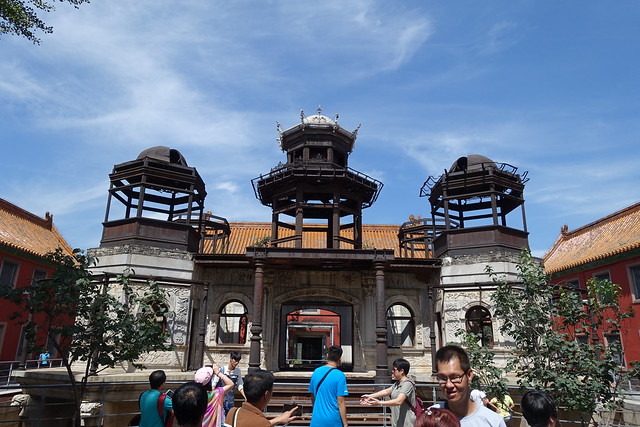

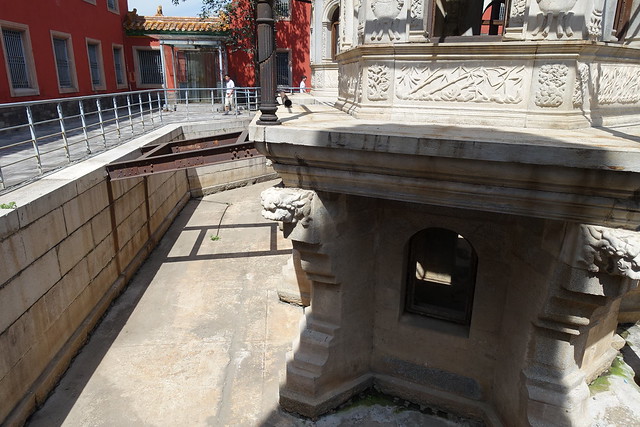 More to be found along the Eastern Palaces of the Inner Court. As the morning gave way to mid-afternoon, we were getting pretty tired and not caring to examine every building we passed by.
More to be found along the Eastern Palaces of the Inner Court. As the morning gave way to mid-afternoon, we were getting pretty tired and not caring to examine every building we passed by.
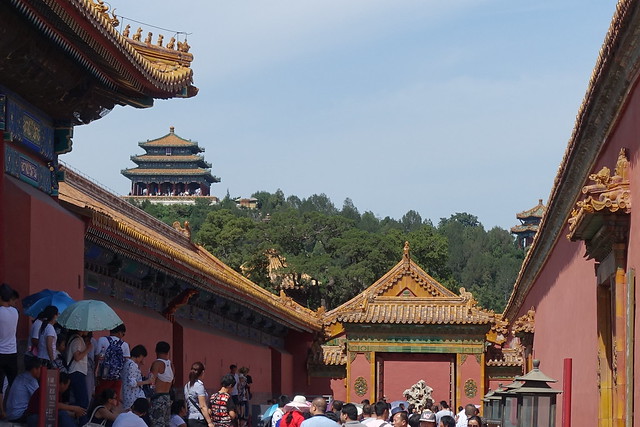
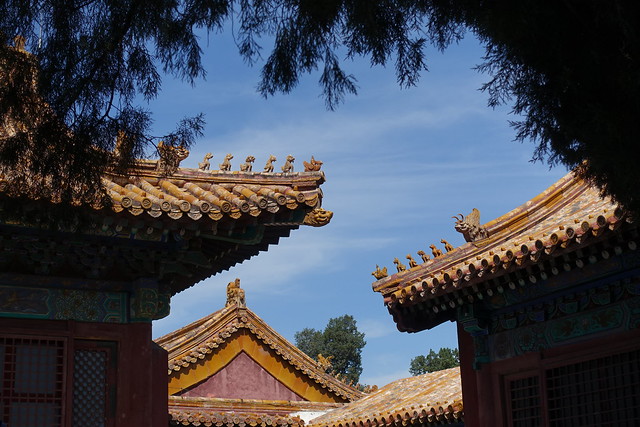

 For a small additional fee, we got to explore the far eastern edge of the Forbidden City, known as the Treasure Gallery area. In addition to several more halls, was home to several displays of artifacts and a few interesting stories. The first among these is the Nine Dragon Screen, apparently one of China’s three great such screens.
For a small additional fee, we got to explore the far eastern edge of the Forbidden City, known as the Treasure Gallery area. In addition to several more halls, was home to several displays of artifacts and a few interesting stories. The first among these is the Nine Dragon Screen, apparently one of China’s three great such screens.
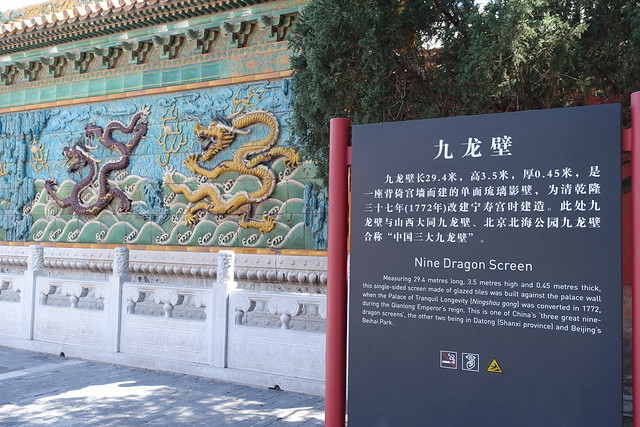
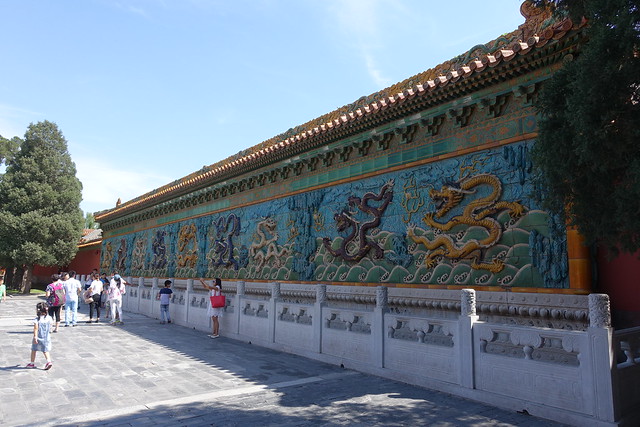
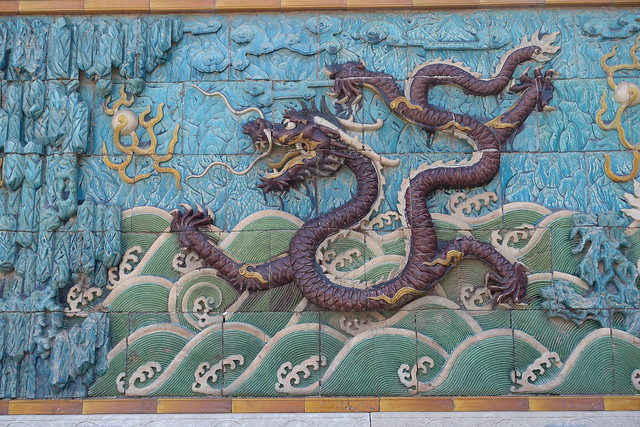
 My favorite story along the audio tour was the story of this wooden dragon belly. Apparently the workers installing the tile accidentally broke it, and as the penalties for such negligence in that era (1700’s) could easily include capital punishment, they decided to make a wooden replica and paint it, so that no one would be the wiser. Years later the paint finally peeled revealing the wood, but by the time it was discovered the workers had presumably long since had a natural passing. And the wooden belly remains.
My favorite story along the audio tour was the story of this wooden dragon belly. Apparently the workers installing the tile accidentally broke it, and as the penalties for such negligence in that era (1700’s) could easily include capital punishment, they decided to make a wooden replica and paint it, so that no one would be the wiser. Years later the paint finally peeled revealing the wood, but by the time it was discovered the workers had presumably long since had a natural passing. And the wooden belly remains.
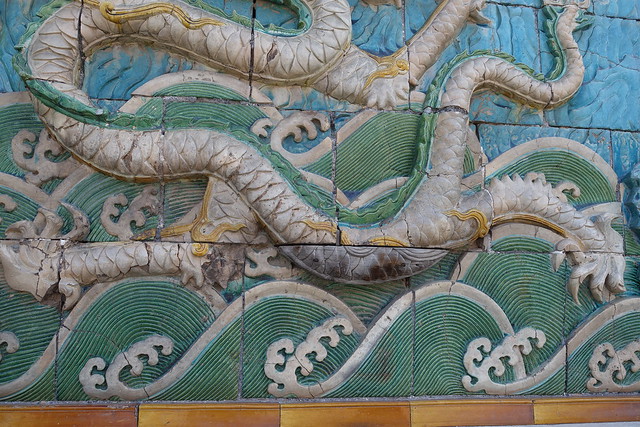 Yiyan at the Gate of Tranquil Longevity. (Sounds like a bad prog rock album.)
Yiyan at the Gate of Tranquil Longevity. (Sounds like a bad prog rock album.)
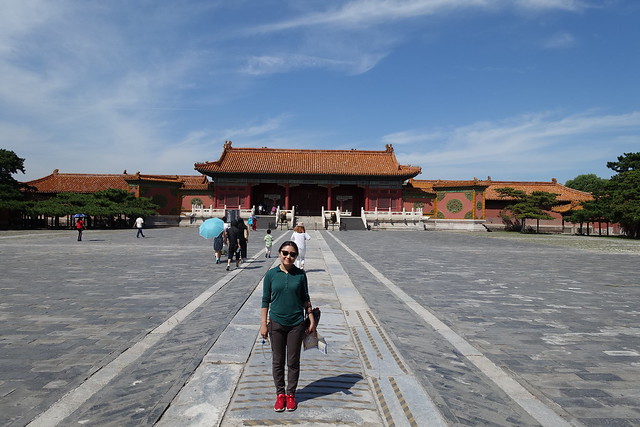

 The Hall of Imperial Supremacy:
The Hall of Imperial Supremacy:

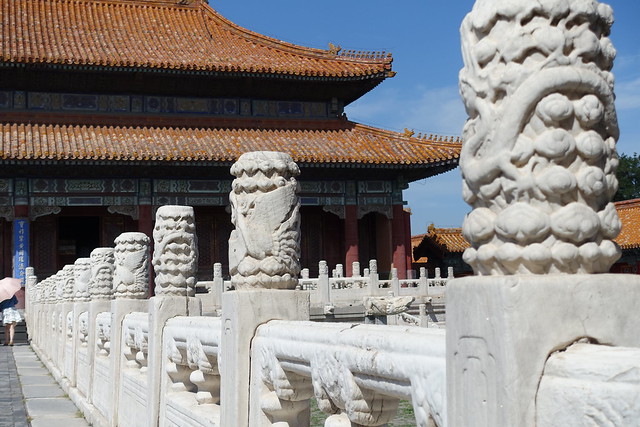
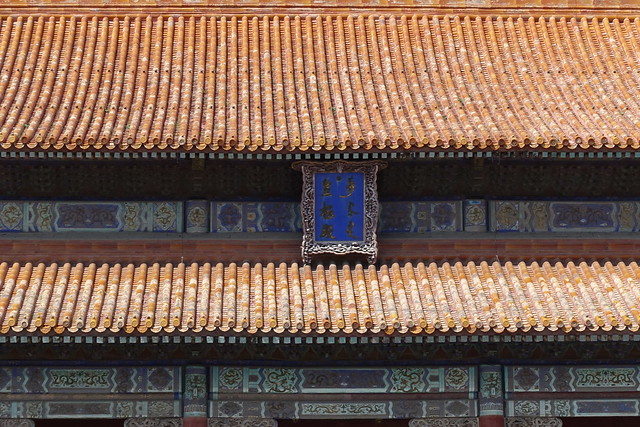

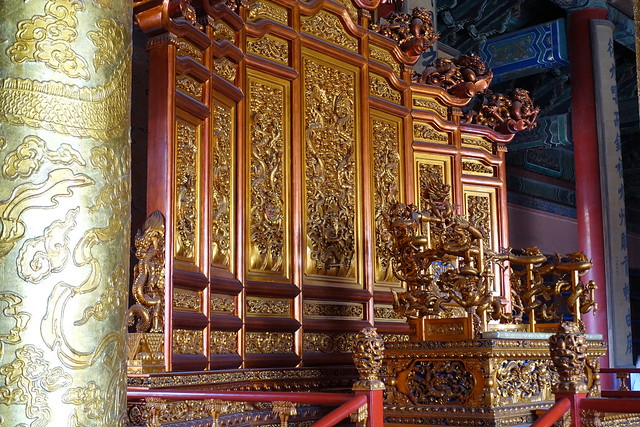

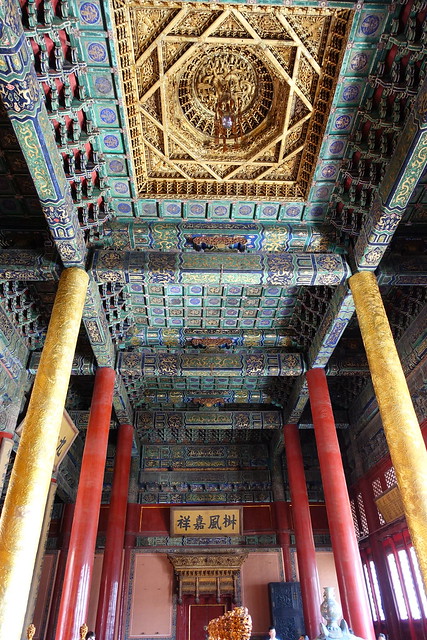 The Studio of Ancient Glory, which sounds like a hipster hangout to me.
The Studio of Ancient Glory, which sounds like a hipster hangout to me.
The Terrace of Gathering Dew features these crazy rock gardens. I’m not sure what type of rock this is or where it comes from, but it was all over the place, with lots of secret places to explore. It’s like the royal Chinese version of Disney’s Tom Sawyer Island.
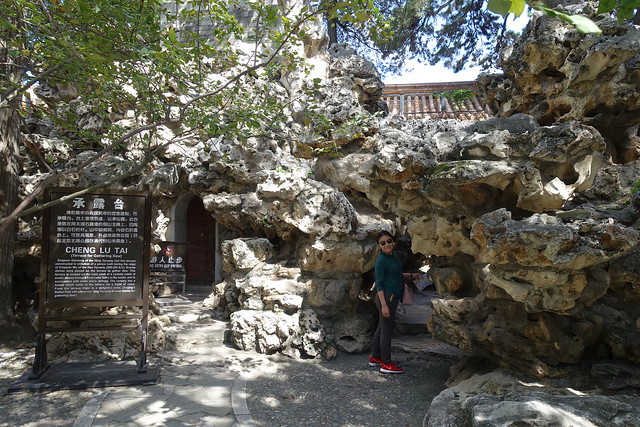
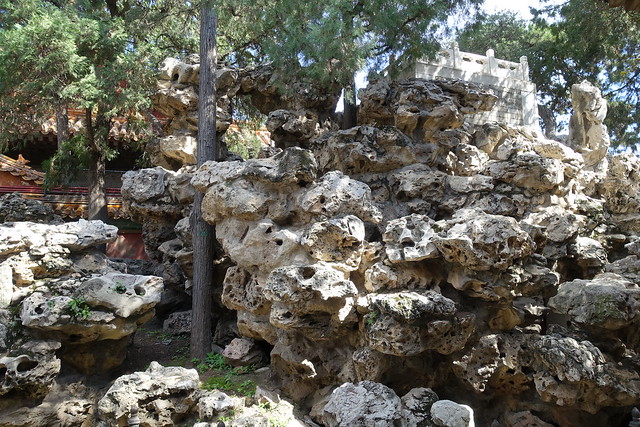
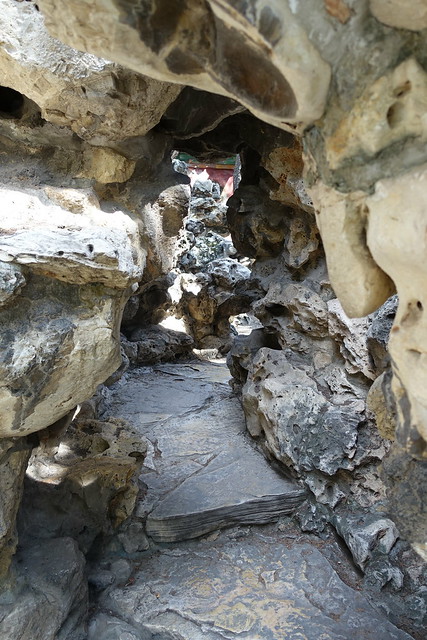 Dragons. Freaking dragons everywhere.
Dragons. Freaking dragons everywhere.
Jade sculpture gallery, featuring some jaw-droppingly enormous carved jade sculptures. (And really bad light control for glass exhibits.)
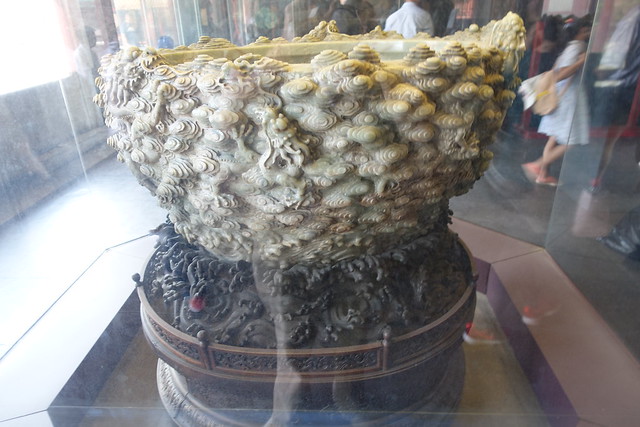
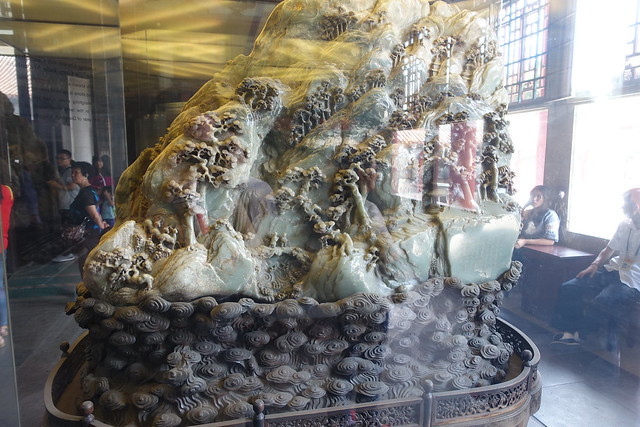
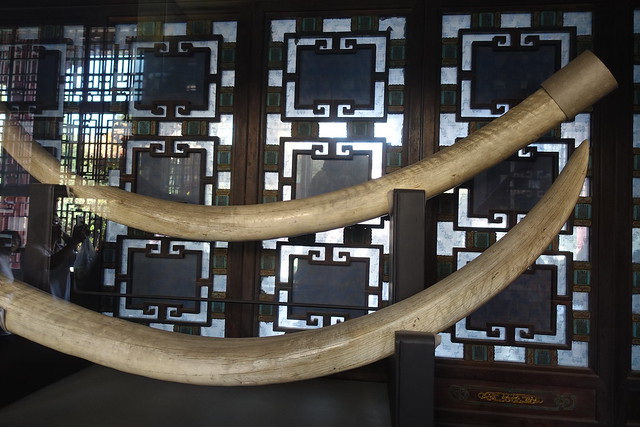
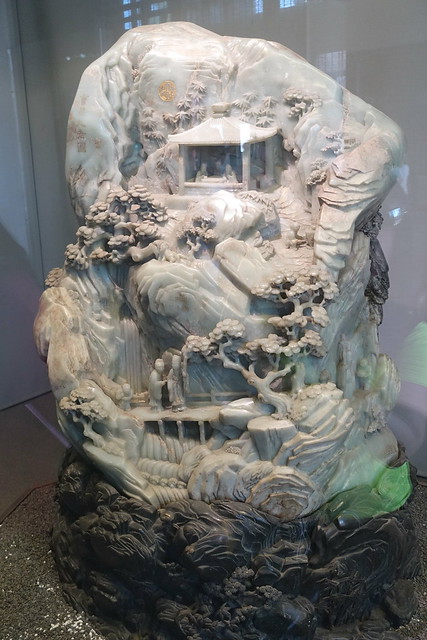 These days the only permanent residents of the Forbidden Cities are the cats.
These days the only permanent residents of the Forbidden Cities are the cats.
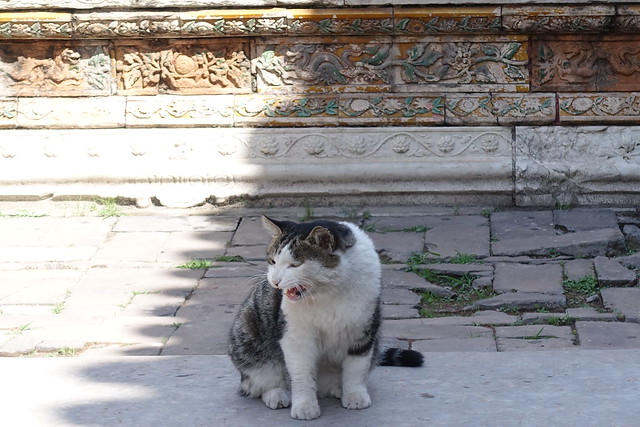
 Almost done… the Hall of Harmony.
Almost done… the Hall of Harmony.
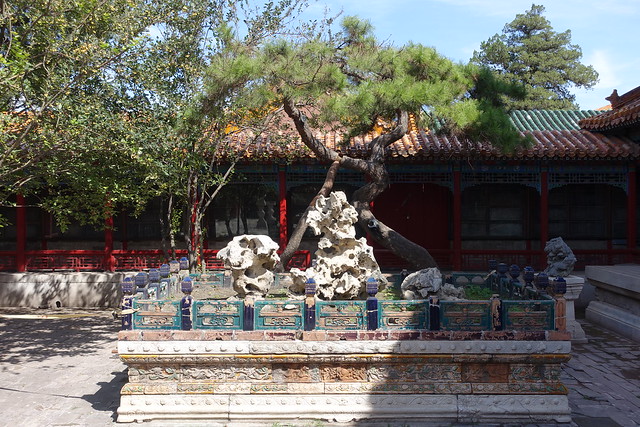
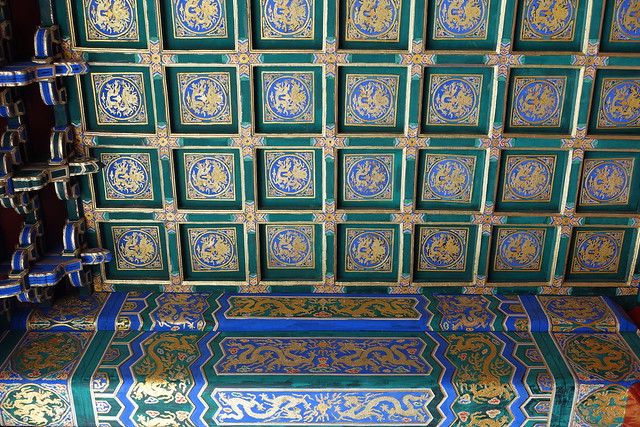
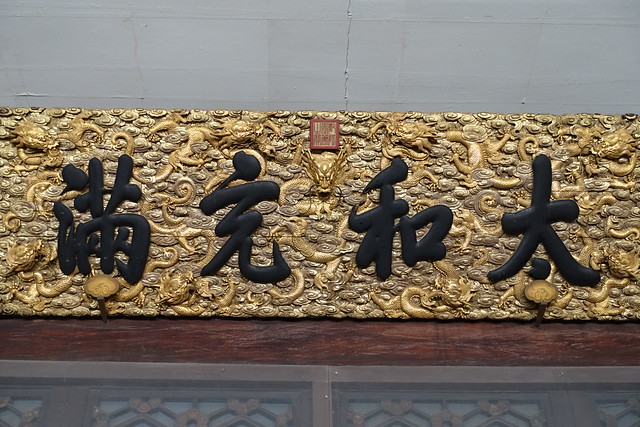
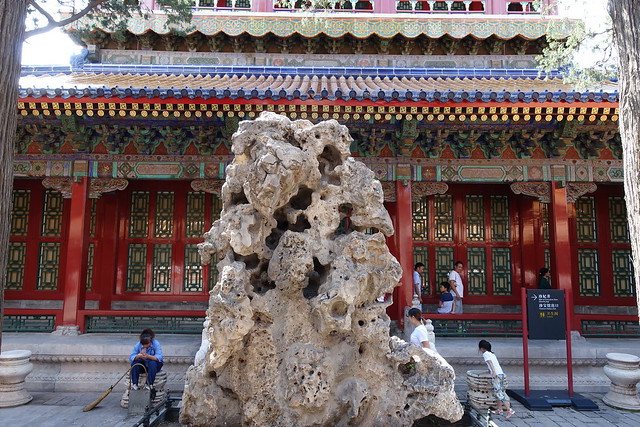
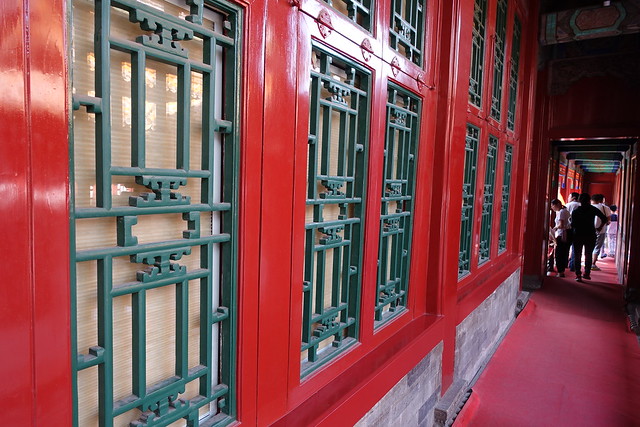 Lastly, the Well of Concubine Zhen. As the story goes, Concubine Zhen was the most beloved by the Emperor Guangxu, who in the late 1800’s supported reforms to modernize China. However, the Dowager Empress Cixi suppressed his efforts, imprisoning the concubine who in 1900 was thrown into the well when the Empress was on the verge of losing her power. The real question is how any adult human ever would have fit in this hole.
Lastly, the Well of Concubine Zhen. As the story goes, Concubine Zhen was the most beloved by the Emperor Guangxu, who in the late 1800’s supported reforms to modernize China. However, the Dowager Empress Cixi suppressed his efforts, imprisoning the concubine who in 1900 was thrown into the well when the Empress was on the verge of losing her power. The real question is how any adult human ever would have fit in this hole.

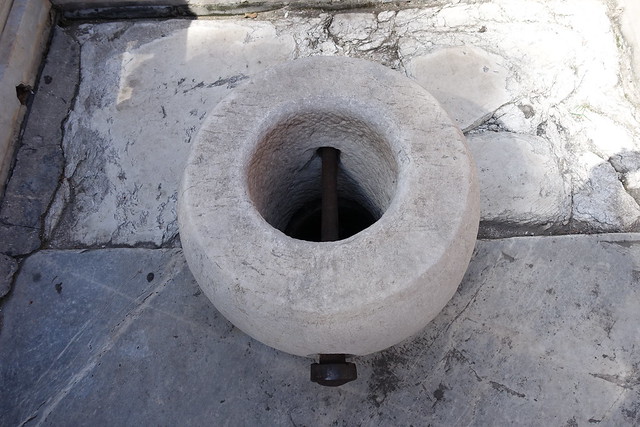 With that, it’s time to wrap up the tour of the Forbidden City. Fans of immersive themed environments that transport you to a time and place will likely find much to enjoy about this attraction, which has the benefit of authenticity while retaining enough familiarity with a theme park experience. (Single entry point, grandiose entry sequence, range of attractions from A to E-ticket, tacky gift shops.)
With that, it’s time to wrap up the tour of the Forbidden City. Fans of immersive themed environments that transport you to a time and place will likely find much to enjoy about this attraction, which has the benefit of authenticity while retaining enough familiarity with a theme park experience. (Single entry point, grandiose entry sequence, range of attractions from A to E-ticket, tacky gift shops.)
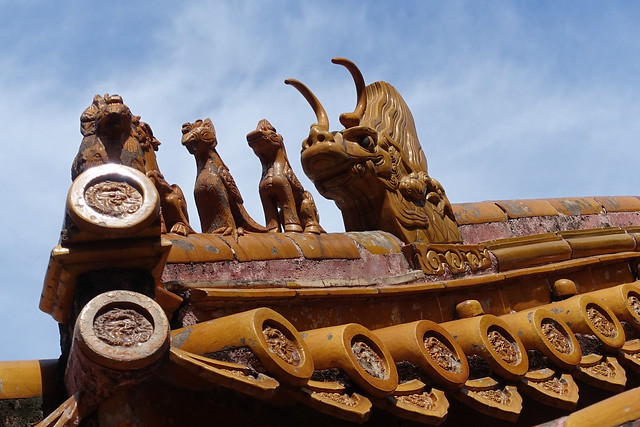 Exit is through the Spiritual Valor Gate, on the exact opposite end of the Forbidden City from which we entered.
Exit is through the Spiritual Valor Gate, on the exact opposite end of the Forbidden City from which we entered.
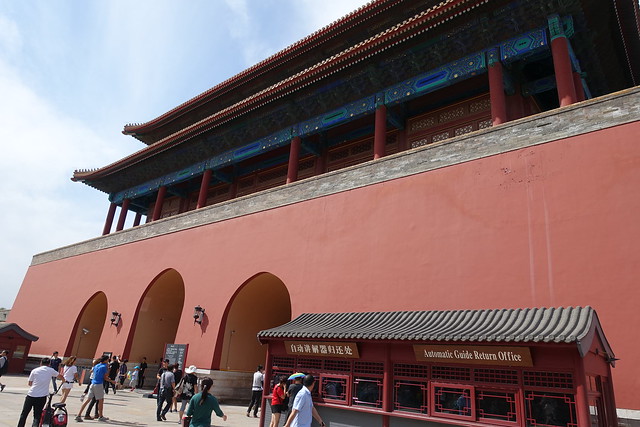
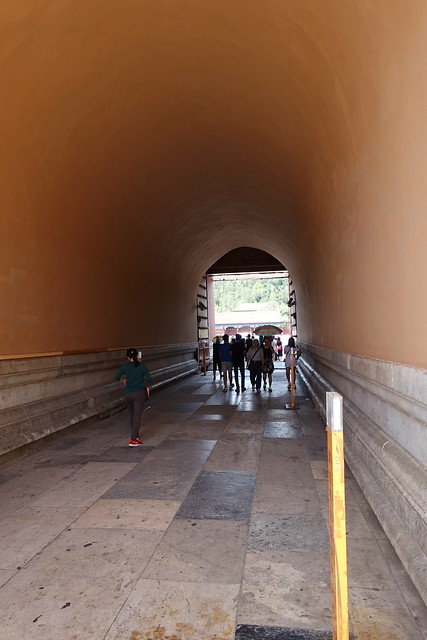 The Chinese translation must be “See Ya Real Soon!”
The Chinese translation must be “See Ya Real Soon!”
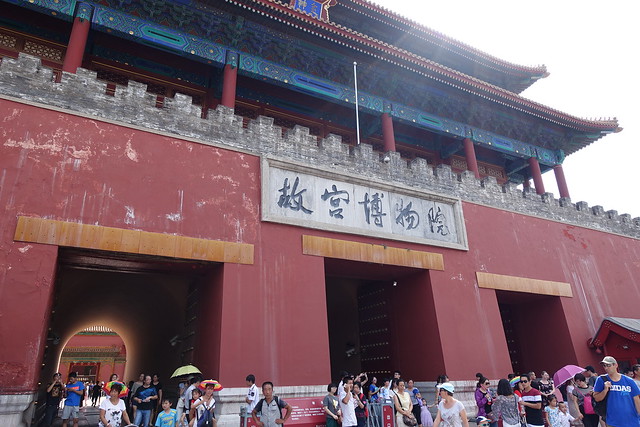 The Tongzi Moat surrounds the Forbidden City. Look at how far it goes, and that’s not even half the length.
The Tongzi Moat surrounds the Forbidden City. Look at how far it goes, and that’s not even half the length.
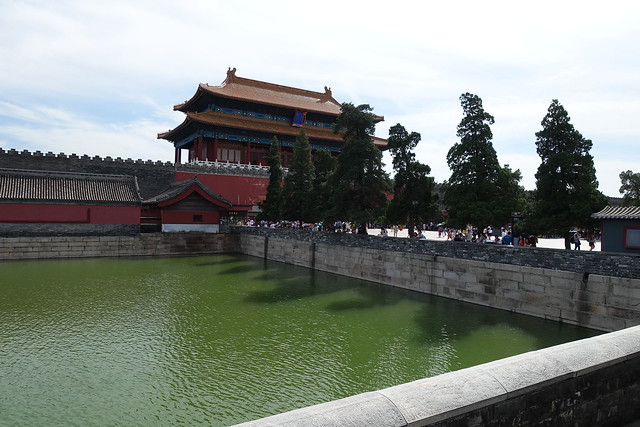
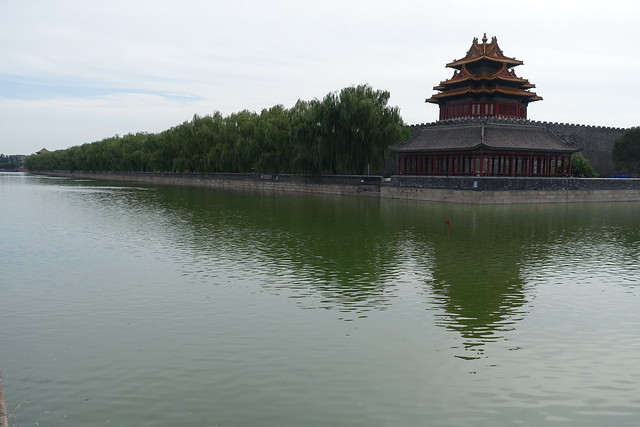 Later in the afternoon, we went back to the Tienanmen Gate in the front of the Forbidden City to climb it and have an overview of Tienanmen Square. A word of advice: if you plan to do this, do this at the beginning of your Forbidden City tour, as they way they have the entrances and exits set up means you have to do a stupid amount of redundant walking otherwise.
Later in the afternoon, we went back to the Tienanmen Gate in the front of the Forbidden City to climb it and have an overview of Tienanmen Square. A word of advice: if you plan to do this, do this at the beginning of your Forbidden City tour, as they way they have the entrances and exits set up means you have to do a stupid amount of redundant walking otherwise.
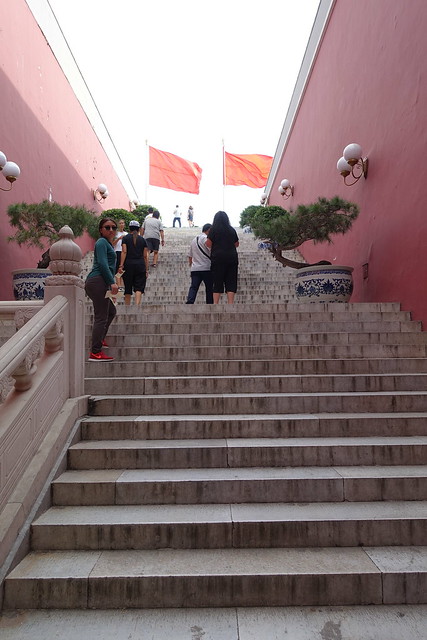
 And… that’s a pretty good view of Tienanmen Square. China’s version of the National Mall, most westerners will probably associate it with a ton of people being massacred in 1989, but few Chinese talk about or acknowledge it today, or will attempt to blame the victims for causing the unrest in the first place. Anyway, don’t let that little fact cloud your view…
And… that’s a pretty good view of Tienanmen Square. China’s version of the National Mall, most westerners will probably associate it with a ton of people being massacred in 1989, but few Chinese talk about or acknowledge it today, or will attempt to blame the victims for causing the unrest in the first place. Anyway, don’t let that little fact cloud your view…
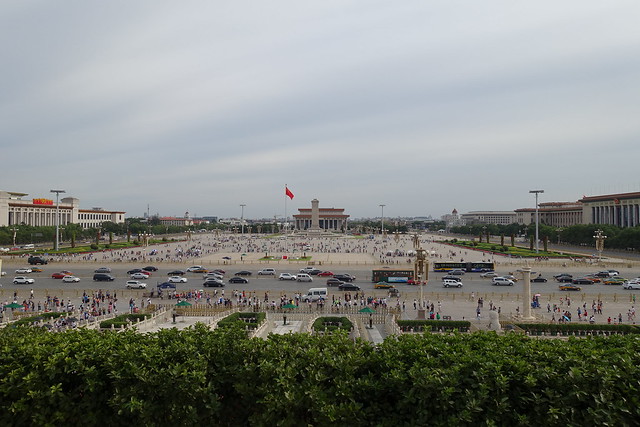
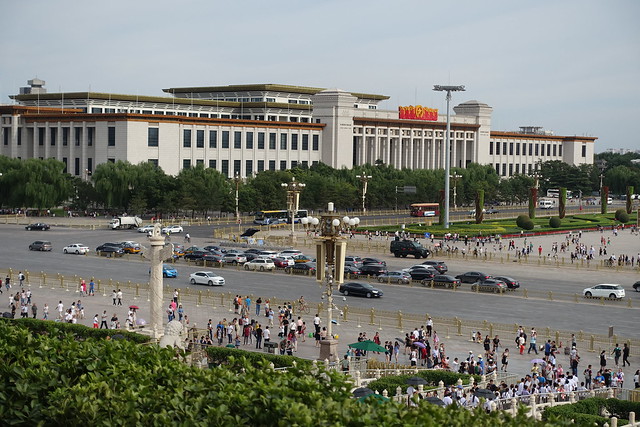
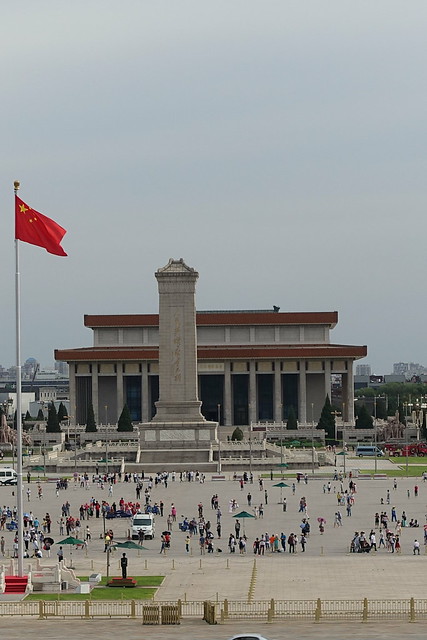

 There’s also a small museum inside Tienanmen Gate where, in proud Chinese tradition, everyone ignores the rules.
There’s also a small museum inside Tienanmen Gate where, in proud Chinese tradition, everyone ignores the rules.
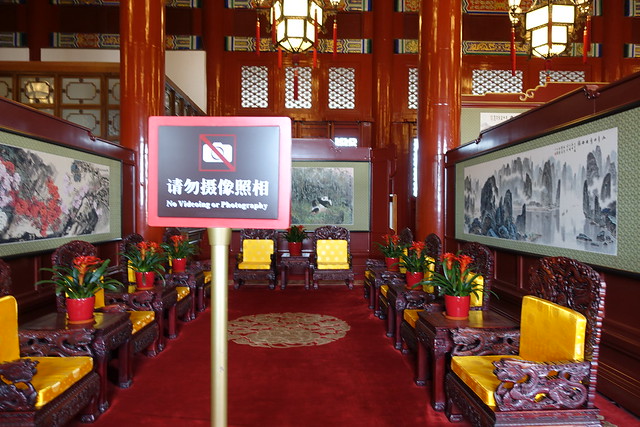 Glimpses of the Forbidden City and Beijing as we make our way back down.
Glimpses of the Forbidden City and Beijing as we make our way back down.
 The evening would not be complete without sampling Beijing’s most famous meal Beijing Roasted Duck. We ate at Da Dong, one of the highest rated roasted duck restaurants in Beijing in the trendy Wangfujing district.
The evening would not be complete without sampling Beijing’s most famous meal Beijing Roasted Duck. We ate at Da Dong, one of the highest rated roasted duck restaurants in Beijing in the trendy Wangfujing district.

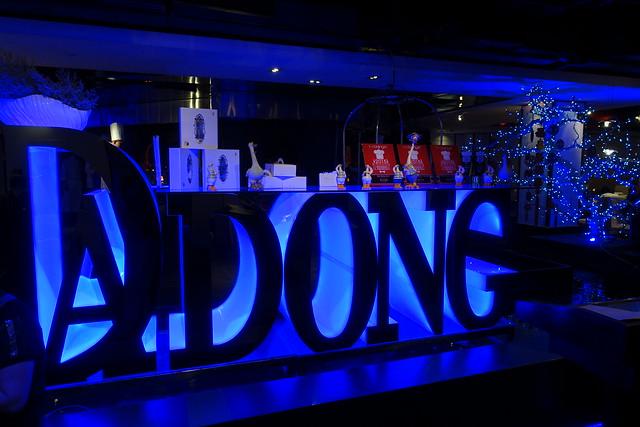
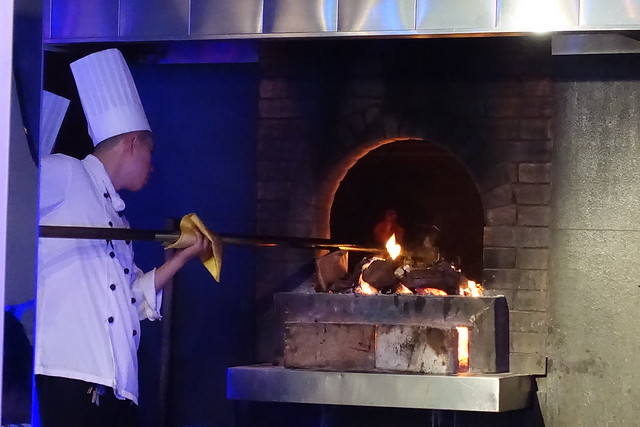
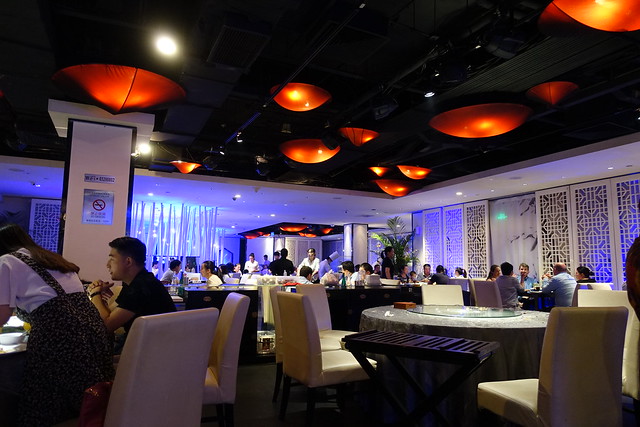 The fattiness of the duck with the crispness of the skin is coated with sugar and wrapped with an assortment of garnishes and sliced veggies, for an extremely tasty and well-balanced meal. We also ordered dessert. Forgive the forthcoming food porn.
The fattiness of the duck with the crispness of the skin is coated with sugar and wrapped with an assortment of garnishes and sliced veggies, for an extremely tasty and well-balanced meal. We also ordered dessert. Forgive the forthcoming food porn.
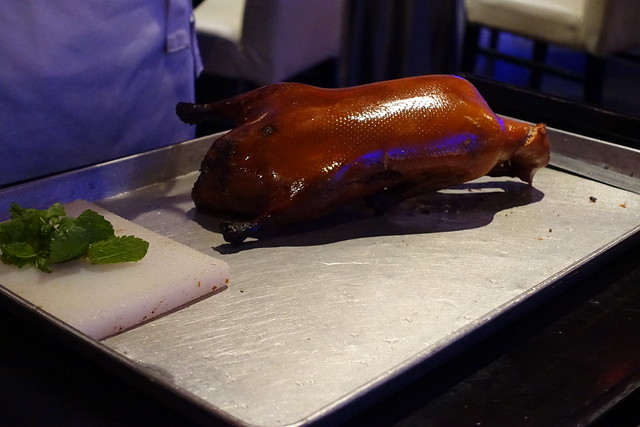

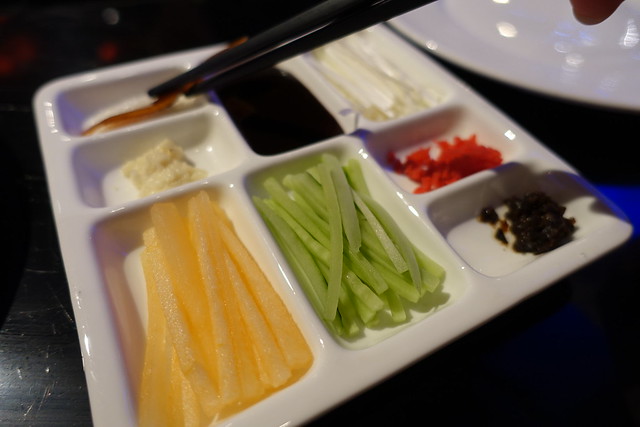

 The next morning we explored the modern Chaoyang district, not far from the famous “underpants” building.
The next morning we explored the modern Chaoyang district, not far from the famous “underpants” building.
“Chicken Method, Taste Childhood.” Yiyan and I had the opportunity to visit the newly opened Thinkwell Asia office and meet some of the folk whom I’d previously only worked with over video conference calls. Last time I was in China in 2011, I’d never have been able to imagine being able to take this photo a mere five years later.
Yiyan and I had the opportunity to visit the newly opened Thinkwell Asia office and meet some of the folk whom I’d previously only worked with over video conference calls. Last time I was in China in 2011, I’d never have been able to imagine being able to take this photo a mere five years later.
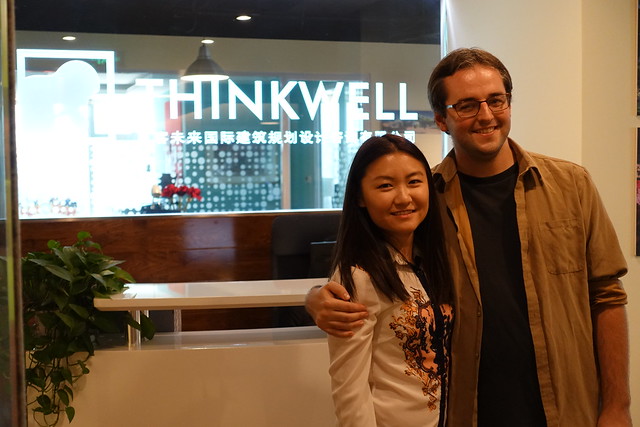 We also stopped at the nearby Taikoo Li mall, which had this unique architecture and fountain.
We also stopped at the nearby Taikoo Li mall, which had this unique architecture and fountain.
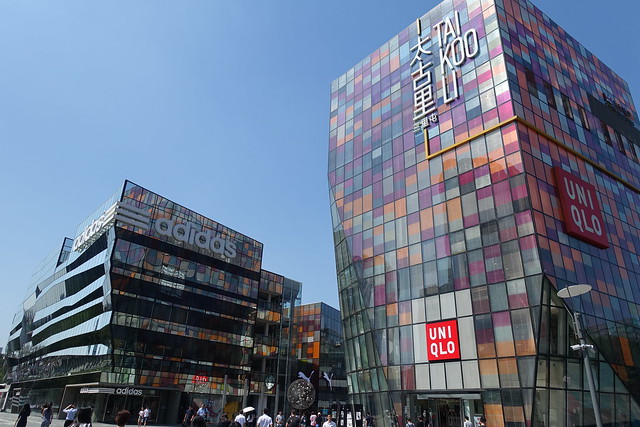
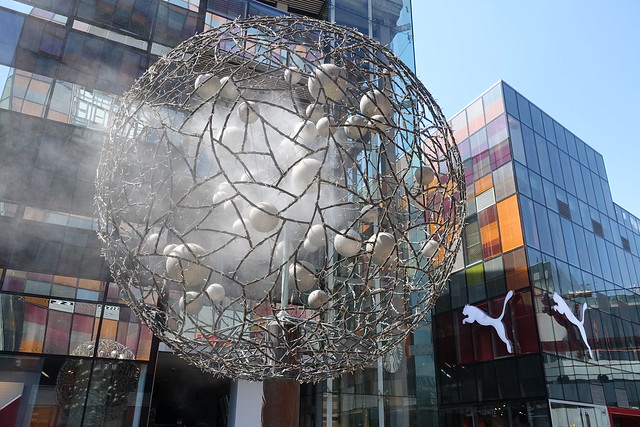 Our main reason for visiting was to try out the Mr. X escape rooms, which I had heard from colleagues were some of the best, most inventive escape rooms they’d ever done. I had actually never done an escape room before, so we decided to give it a try.
Our main reason for visiting was to try out the Mr. X escape rooms, which I had heard from colleagues were some of the best, most inventive escape rooms they’d ever done. I had actually never done an escape room before, so we decided to give it a try.
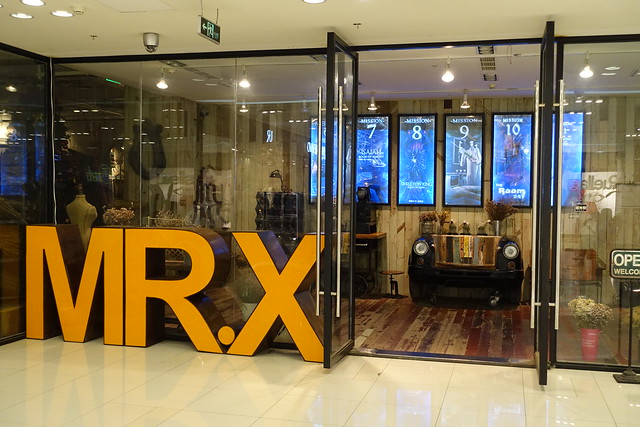 The decor in the lobby is decidedly eclectic. I’m not sure what the Christmas tree is supposed to signify.
The decor in the lobby is decidedly eclectic. I’m not sure what the Christmas tree is supposed to signify.
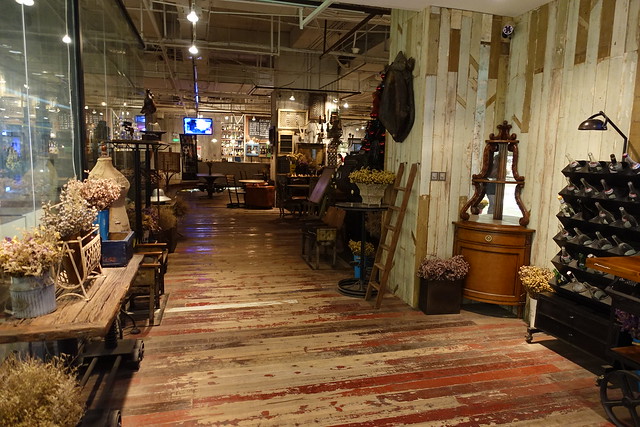
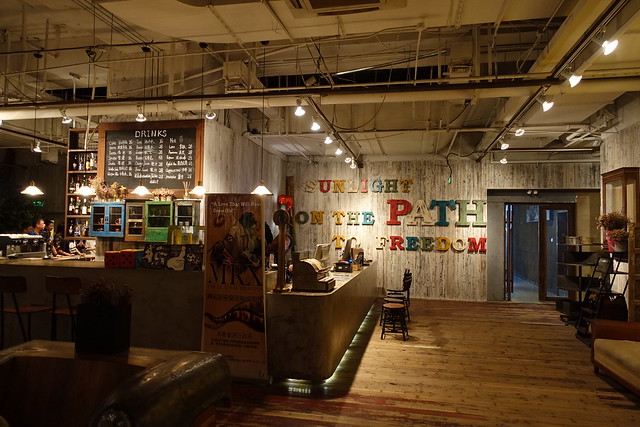

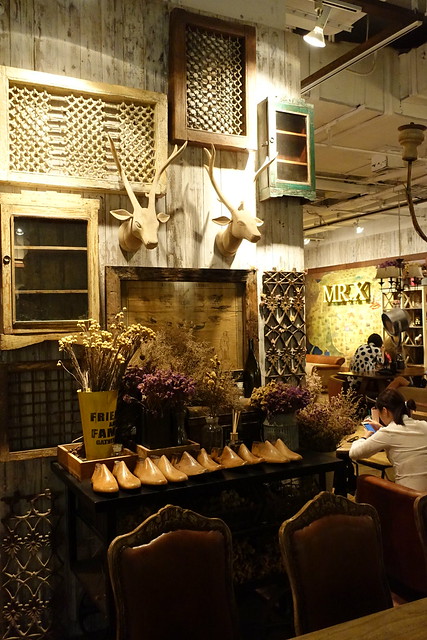
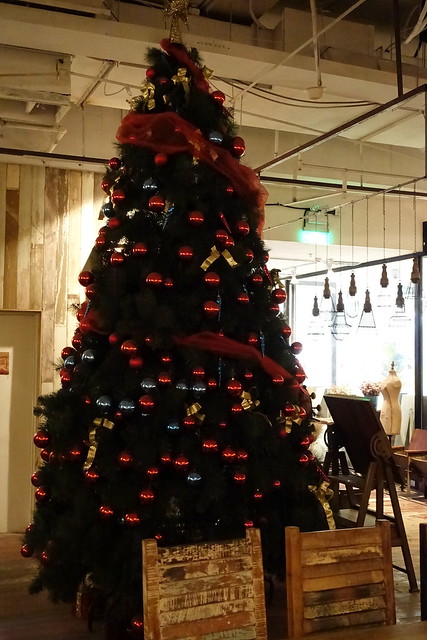 The Escape Room we did was called Skeleton King Book of Dark. I think it might have been one of their earlier escape rooms, as the puzzles and environments were all fairly simple without anywhere near the level of sophistication I had heard at least one of their other rooms had. It was however fairly easy, which was good for us especially as Yiyan and I were the only ones in it that afternoon. We ended up nearly solving it, although the very last puzzle we got stuck on and decided to use our free hint, which they ended up solving the whole thing for us and showing us the way out. Had I known it was the very last puzzle I would have used the rest of the time trying to figure it out, but I wanted to be sure there wasn’t something spectacular in the next room I might have missed. Given that Yiyan and I were able to solve it on our own indicates how easy it must have been. Anyway, it was still a good experience that I’m glad I tried, although next time I’m back in Beijing for either work or leisure I’ll have to try one of their more challenging puzzles.
The Escape Room we did was called Skeleton King Book of Dark. I think it might have been one of their earlier escape rooms, as the puzzles and environments were all fairly simple without anywhere near the level of sophistication I had heard at least one of their other rooms had. It was however fairly easy, which was good for us especially as Yiyan and I were the only ones in it that afternoon. We ended up nearly solving it, although the very last puzzle we got stuck on and decided to use our free hint, which they ended up solving the whole thing for us and showing us the way out. Had I known it was the very last puzzle I would have used the rest of the time trying to figure it out, but I wanted to be sure there wasn’t something spectacular in the next room I might have missed. Given that Yiyan and I were able to solve it on our own indicates how easy it must have been. Anyway, it was still a good experience that I’m glad I tried, although next time I’m back in Beijing for either work or leisure I’ll have to try one of their more challenging puzzles.
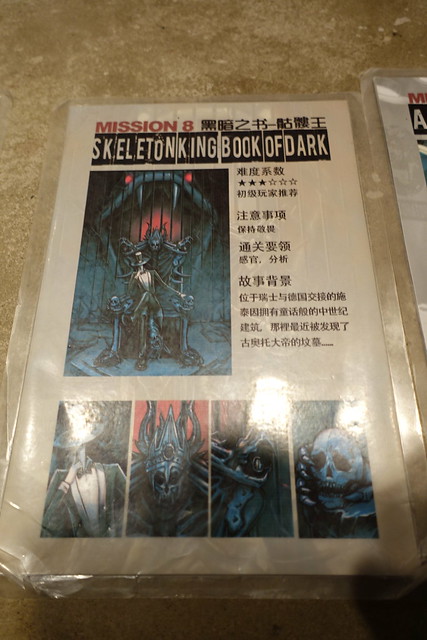 After the game, they offered a prize: if we could each roll double ones, twos, or sixes on these foam dice, we’d win a free ticket. Yiyan didn’t win, but I managed to win snake eyes! (I somewhat cheated, in full view of the staff, by making sure the dice were aligned for snake eyes when I gently tossed them together as straight as I could.) Too bad the ticket expired in two months so it was of no use to me besides the satisfaction of winning.
After the game, they offered a prize: if we could each roll double ones, twos, or sixes on these foam dice, we’d win a free ticket. Yiyan didn’t win, but I managed to win snake eyes! (I somewhat cheated, in full view of the staff, by making sure the dice were aligned for snake eyes when I gently tossed them together as straight as I could.) Too bad the ticket expired in two months so it was of no use to me besides the satisfaction of winning.
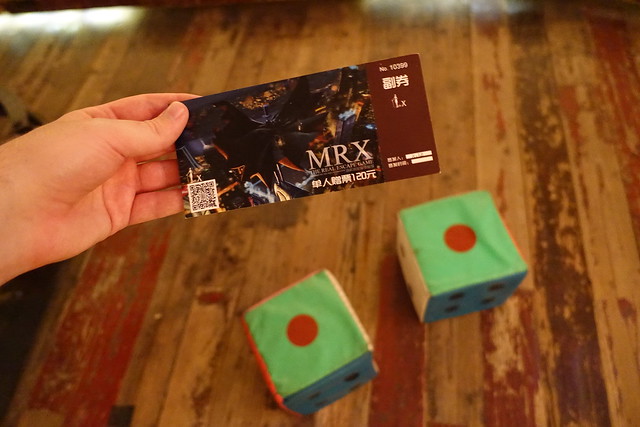 Some random gates spotted around Beijing.
Some random gates spotted around Beijing.

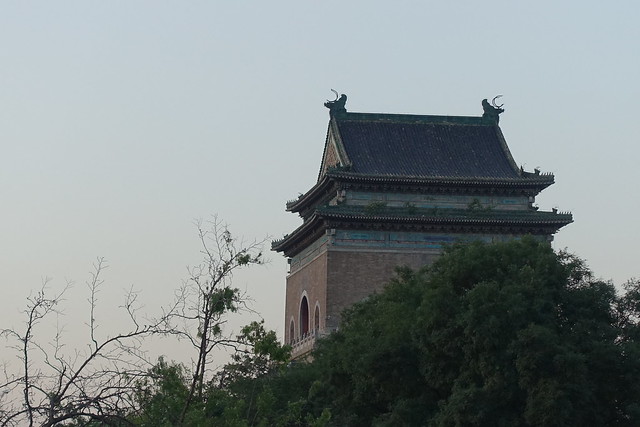 For our last full evening in Beijing, we explored the Houhai lake area around the Xiaoshibei Hutong. A hutong is a Chinese style of old neighborhood typified by small traditional houses and markets and narrow, winding streets. Recently they’ve seen an explosion in market value as many rich residents move in, bringing with them trendy cafes and clubs.
For our last full evening in Beijing, we explored the Houhai lake area around the Xiaoshibei Hutong. A hutong is a Chinese style of old neighborhood typified by small traditional houses and markets and narrow, winding streets. Recently they’ve seen an explosion in market value as many rich residents move in, bringing with them trendy cafes and clubs.
Beijing style barbecue for tonight with Yiyan and her friend.
More shots around the Houhai and the hutong at night.
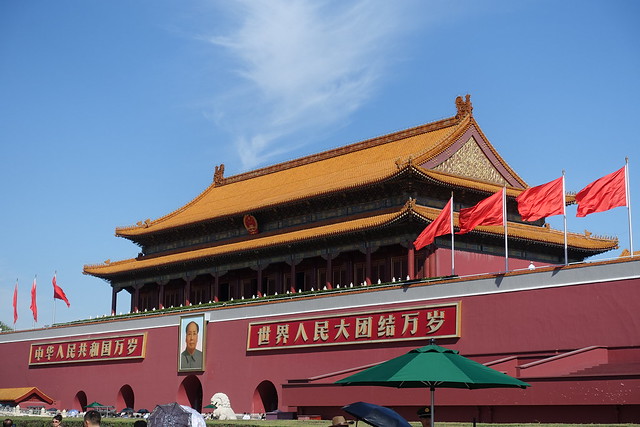

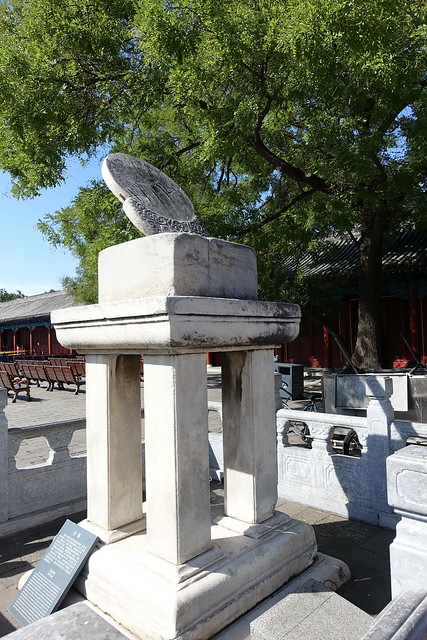

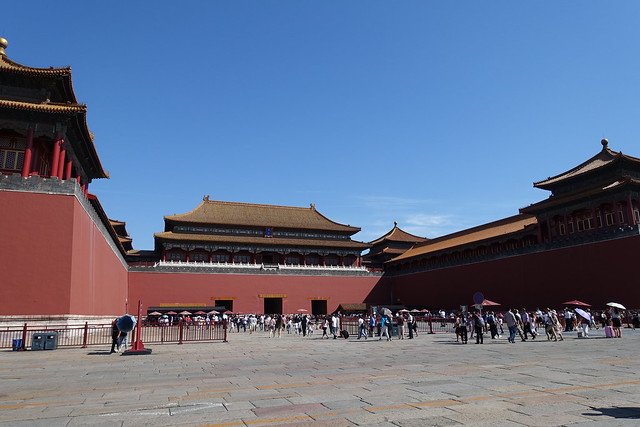
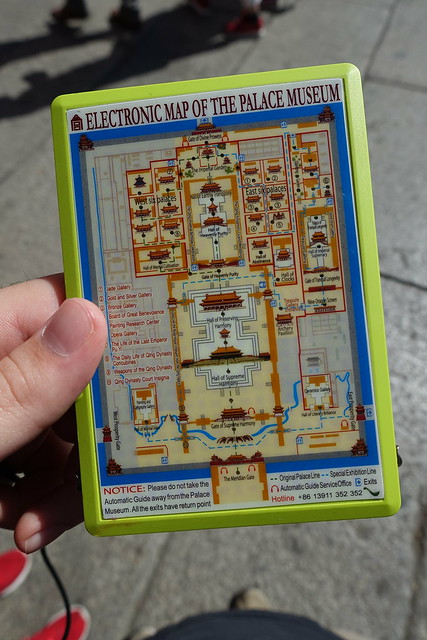
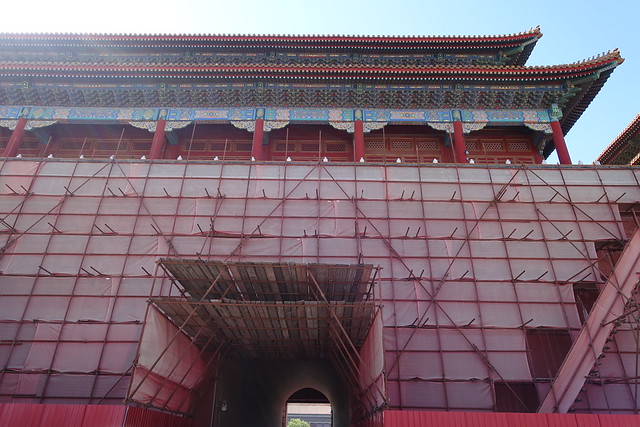
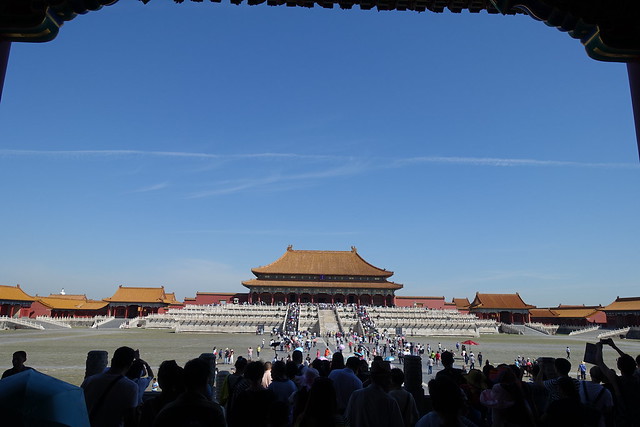


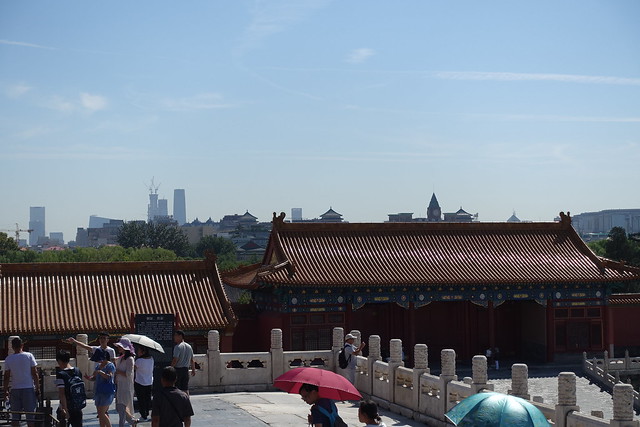
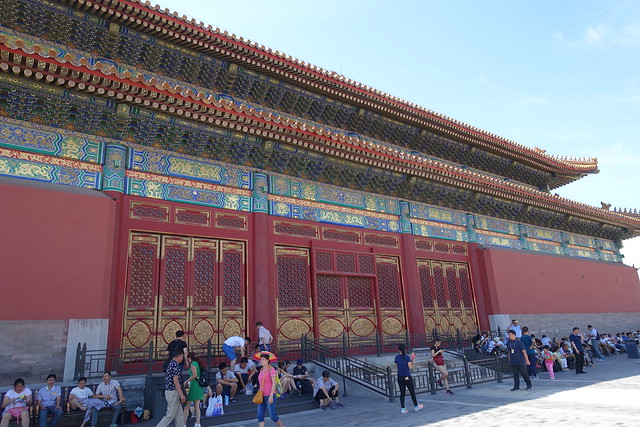
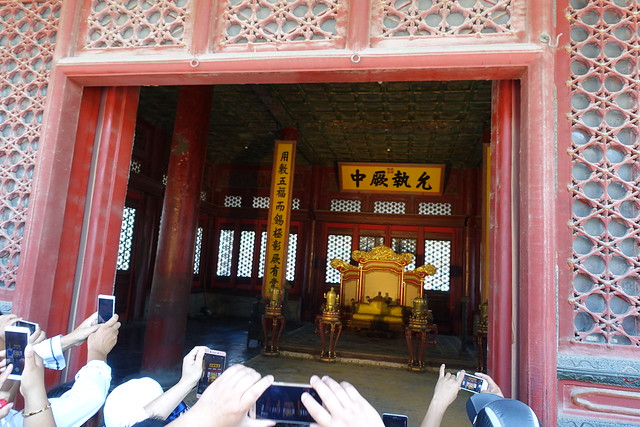
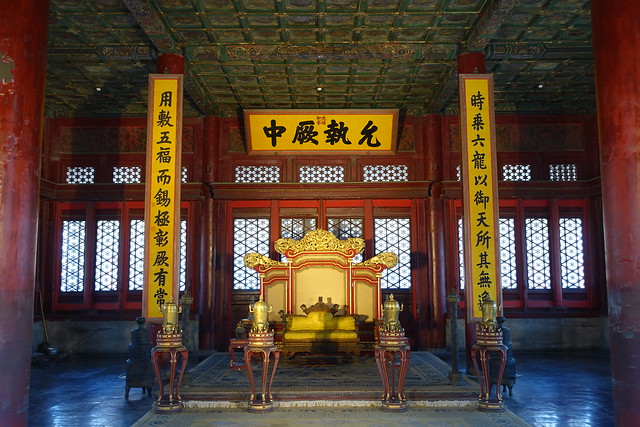



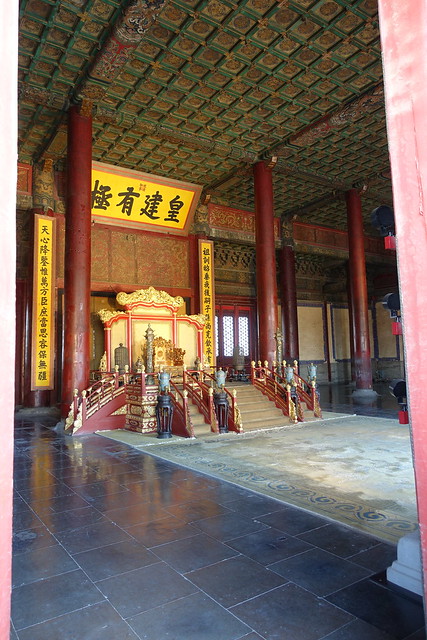


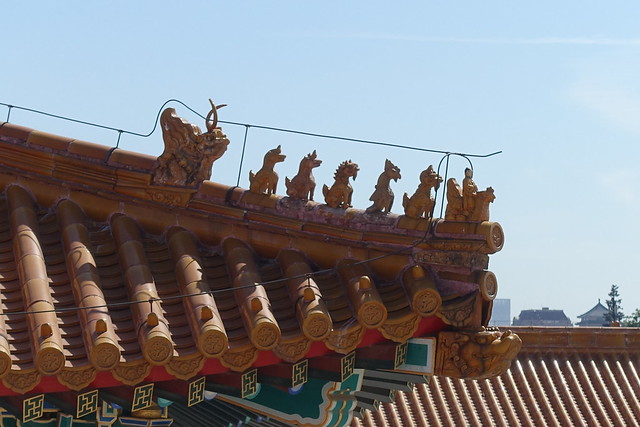

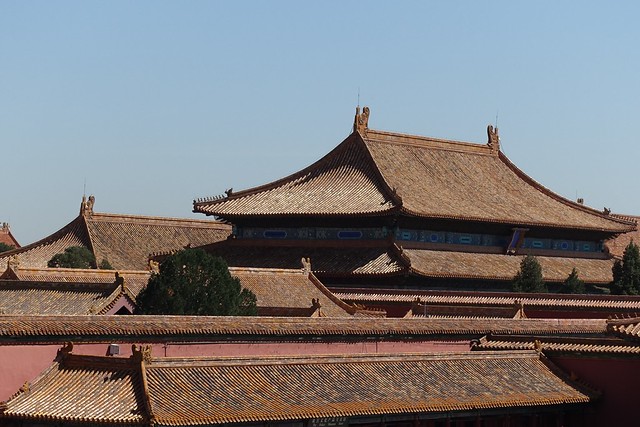
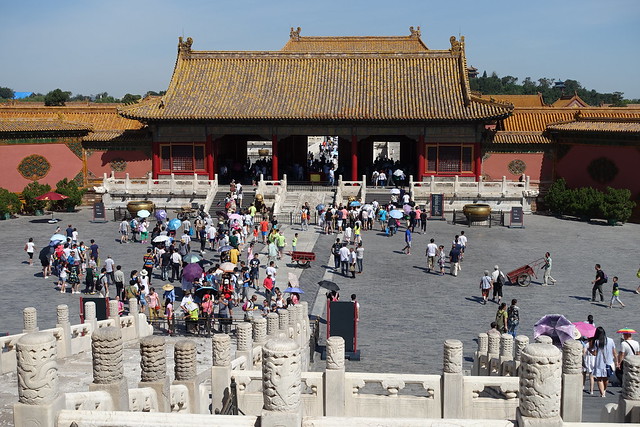
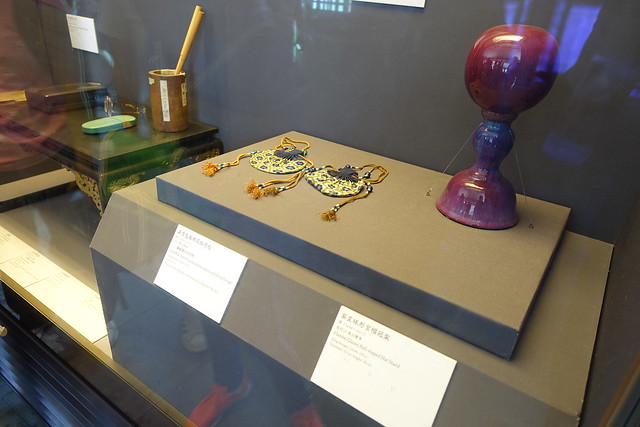

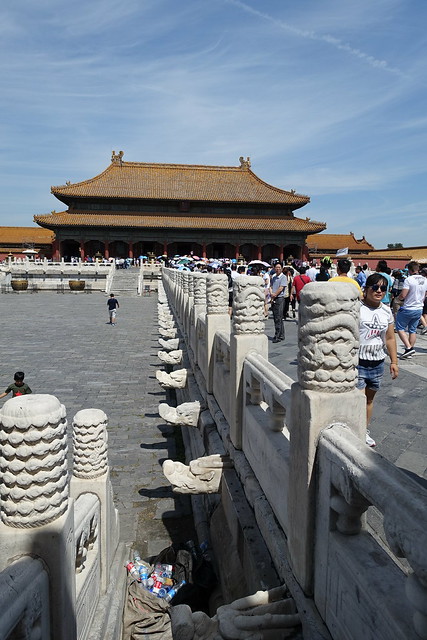
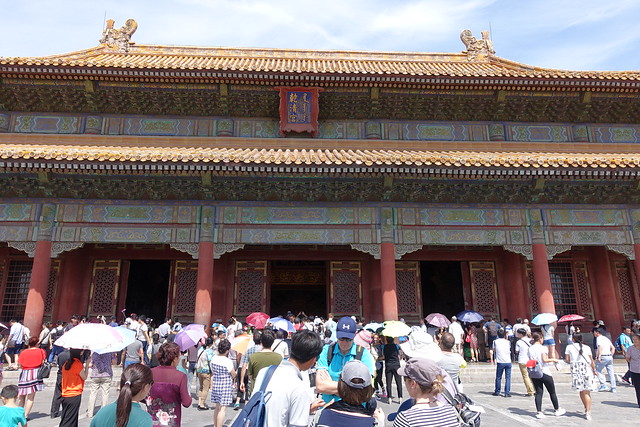
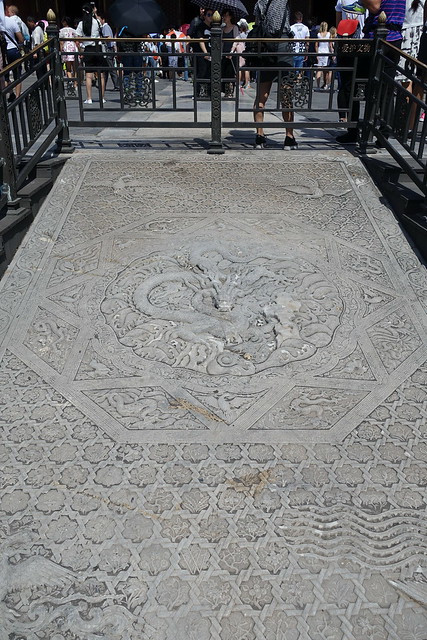

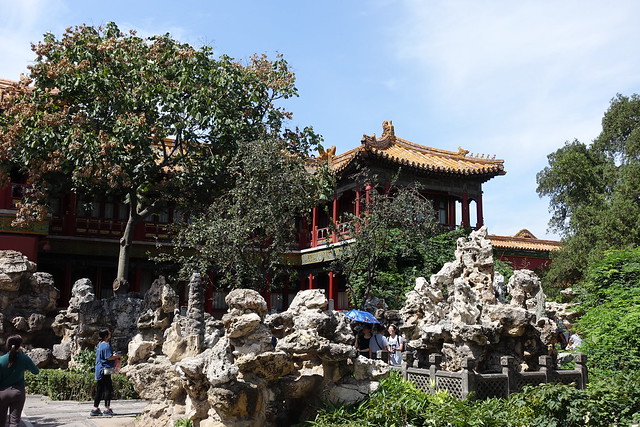
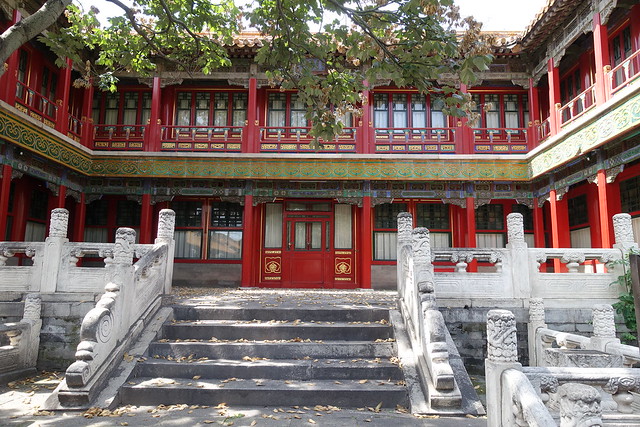






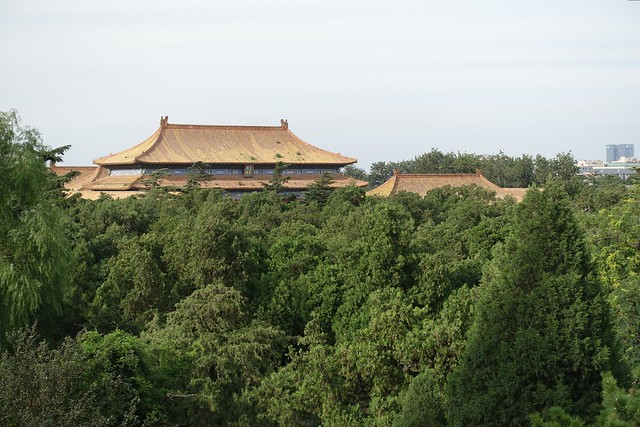
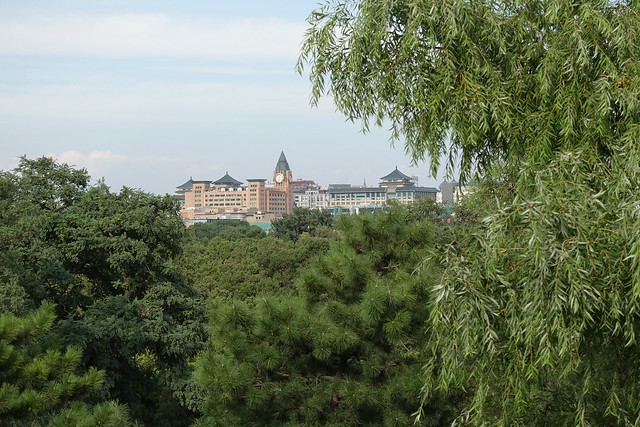
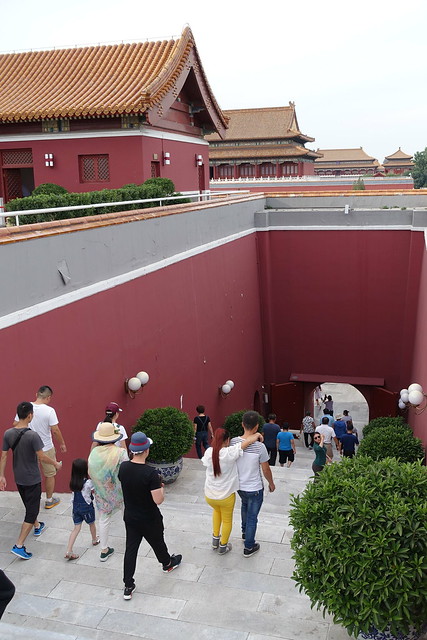


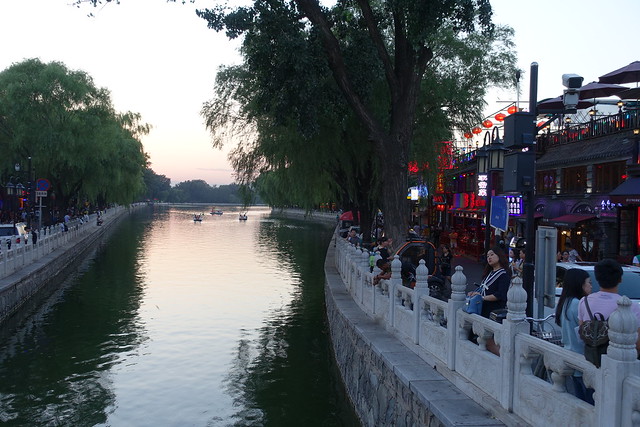
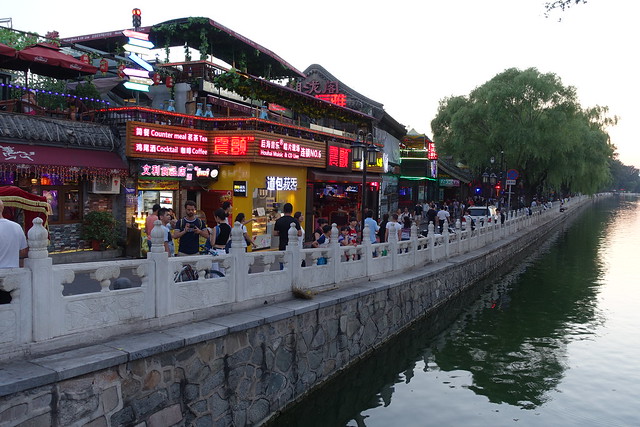
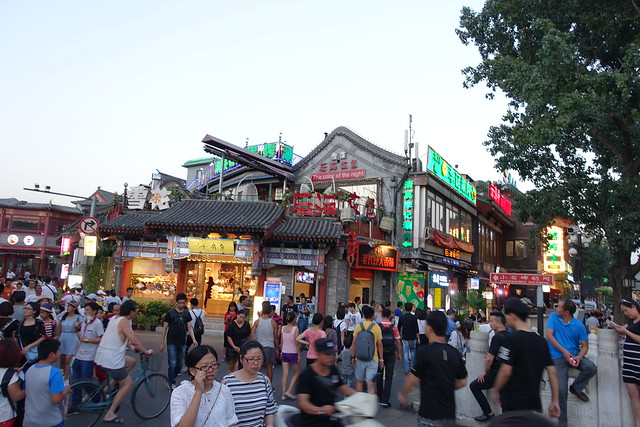
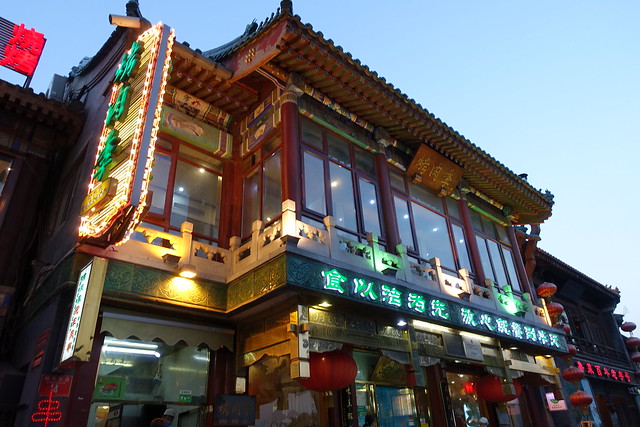
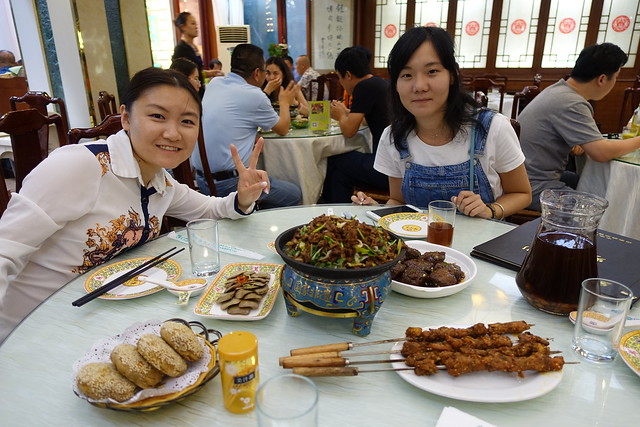
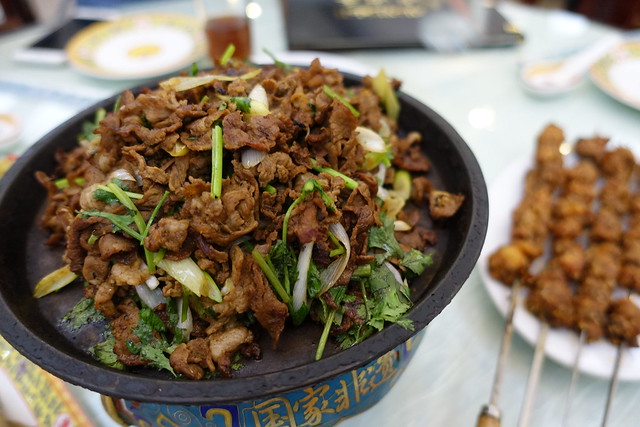
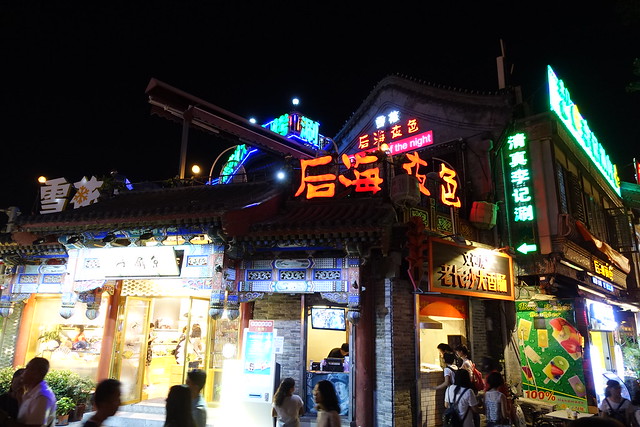
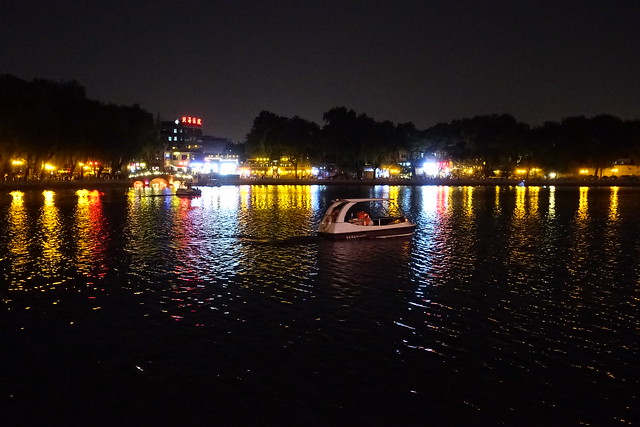
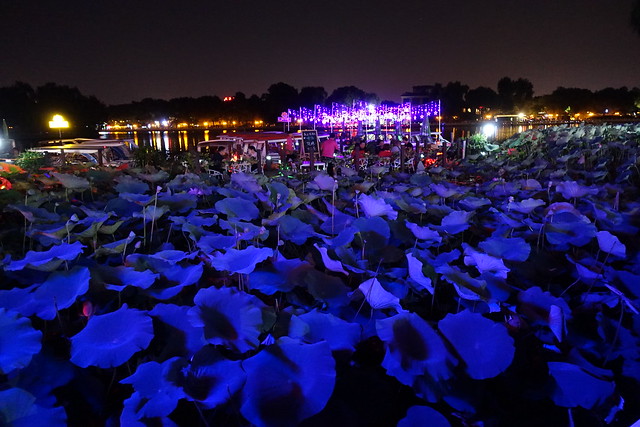

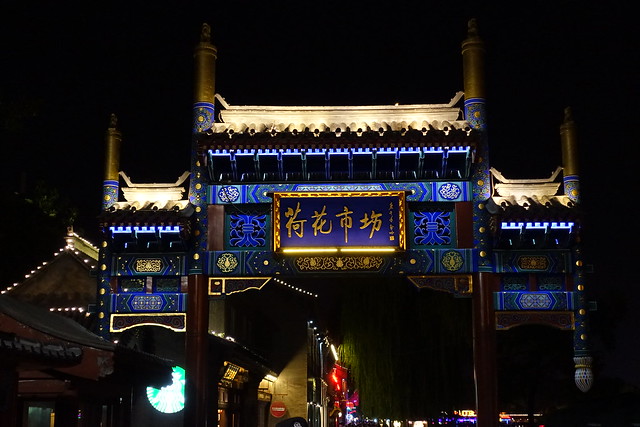
Comments